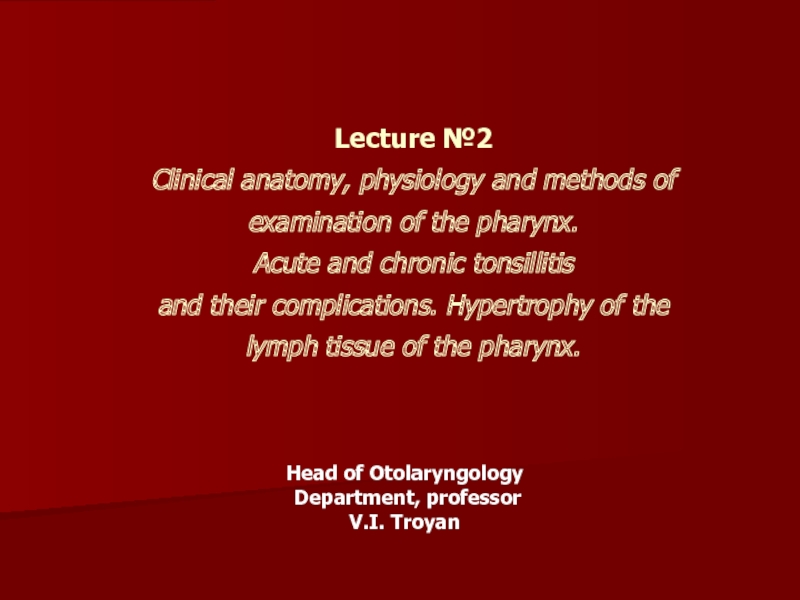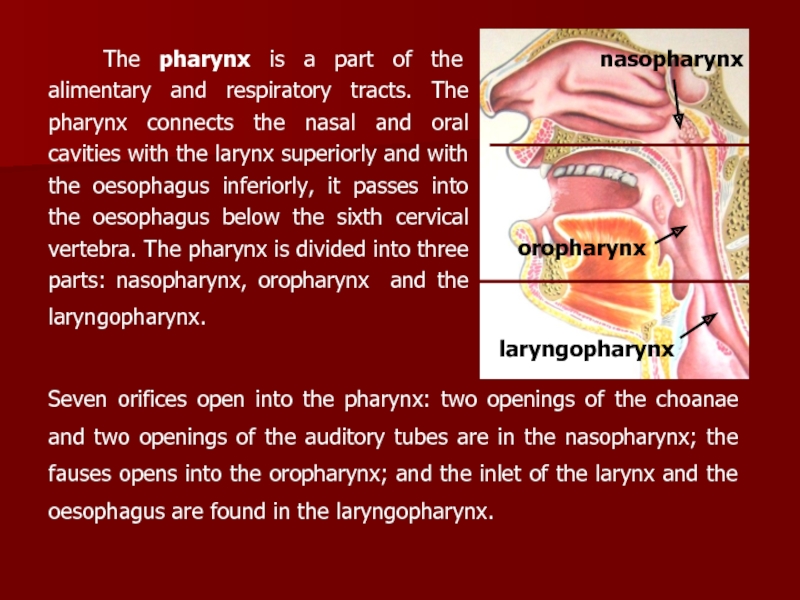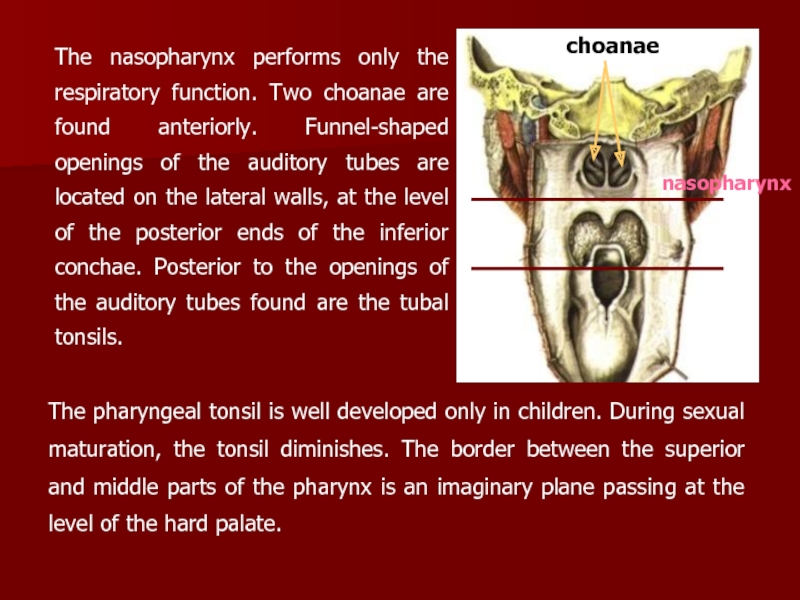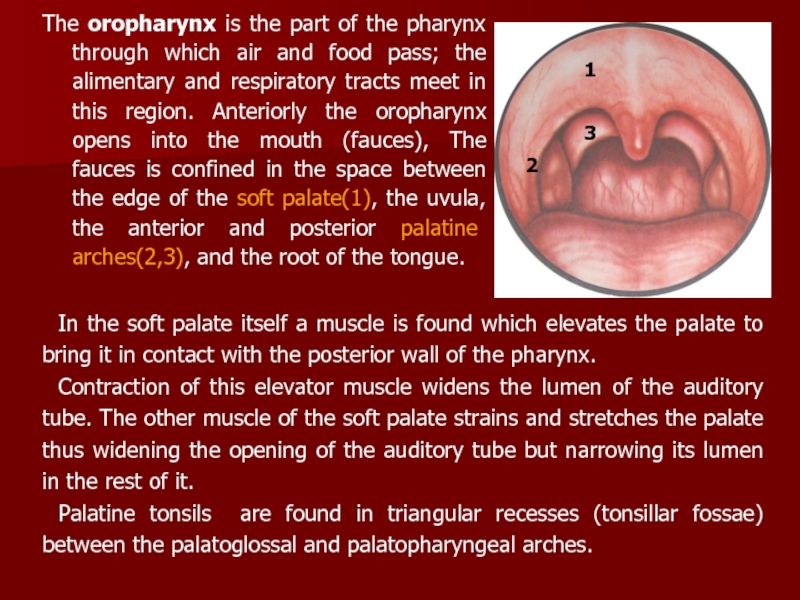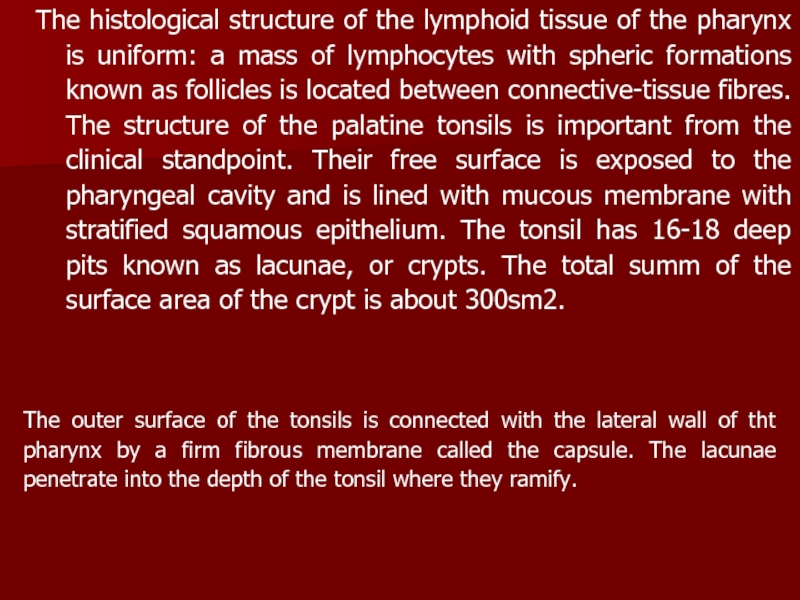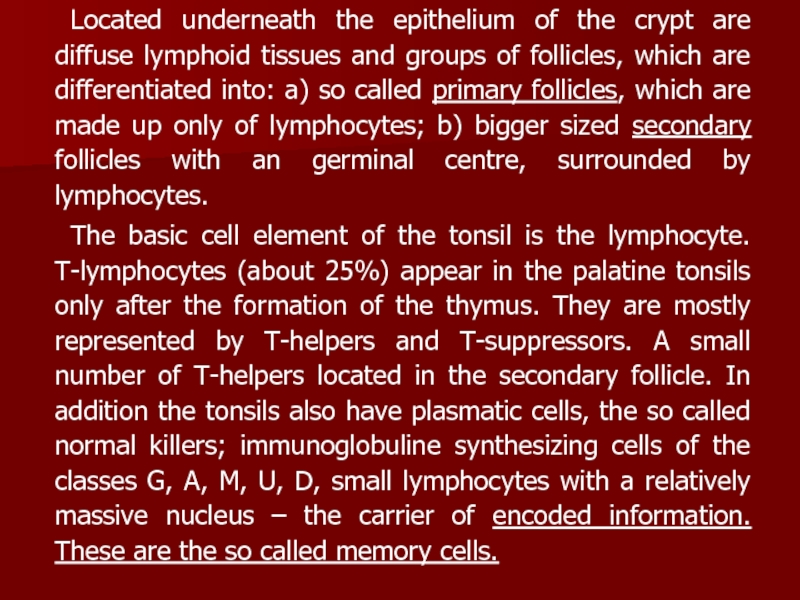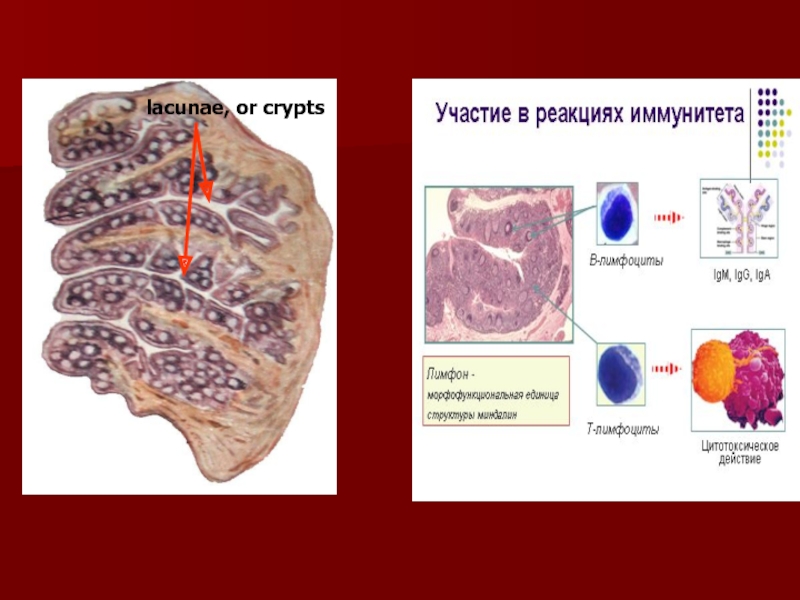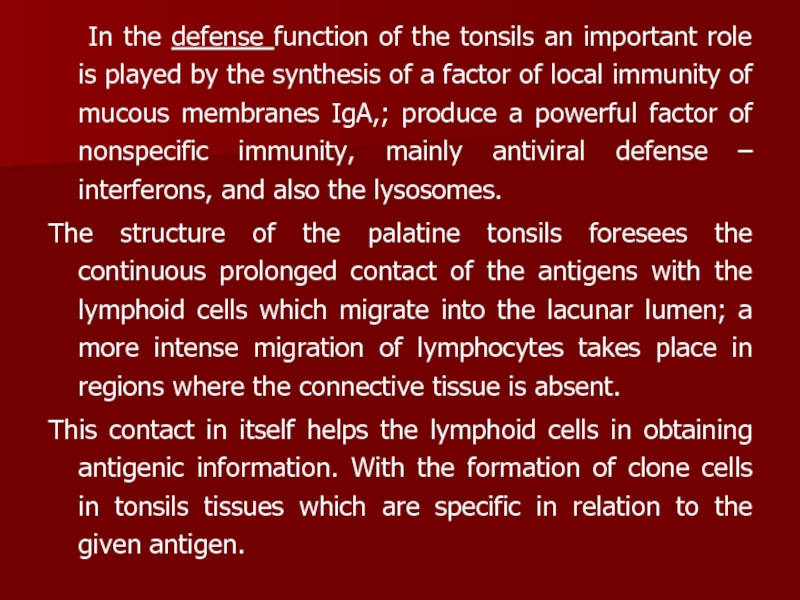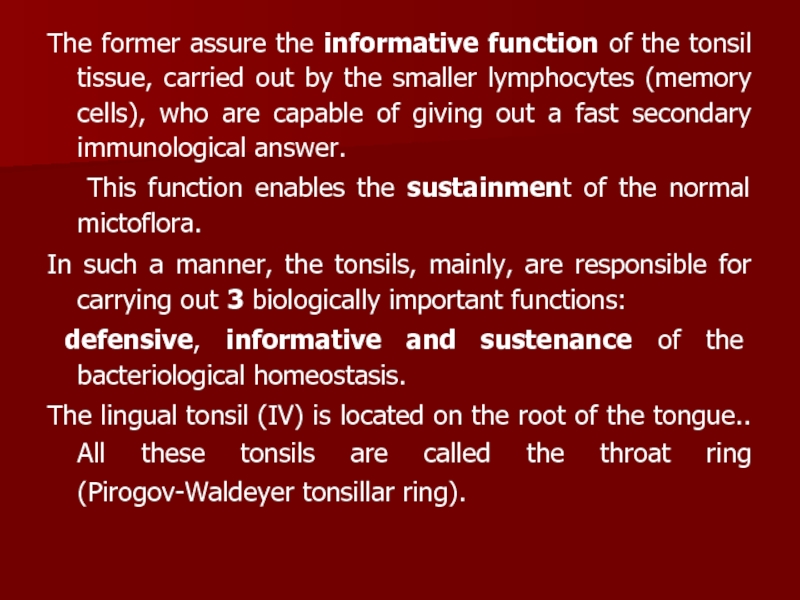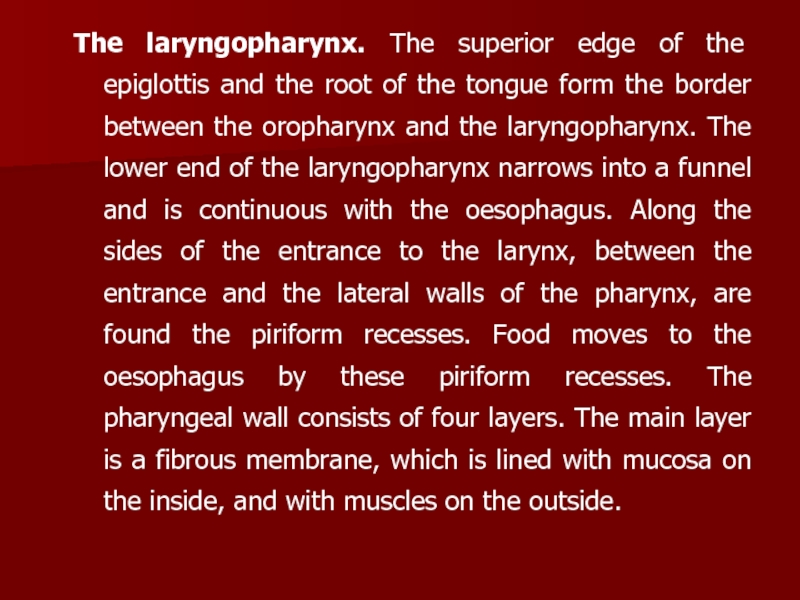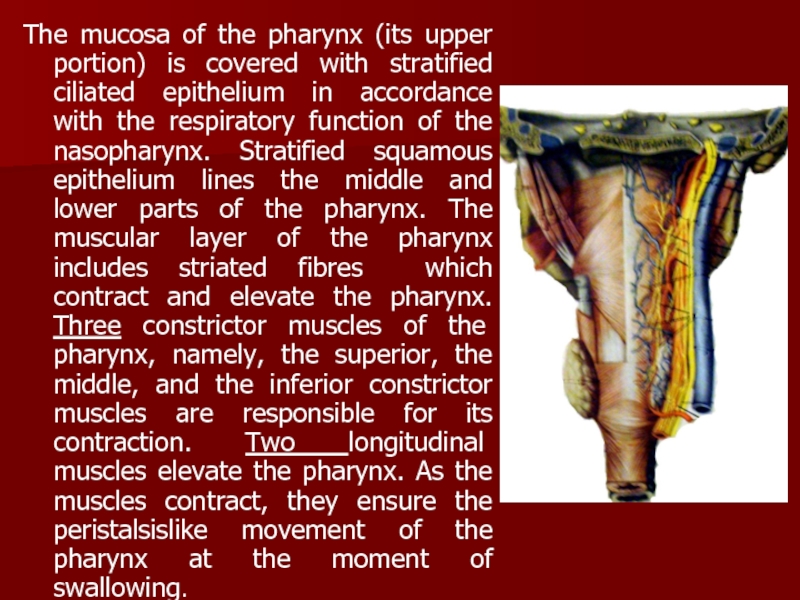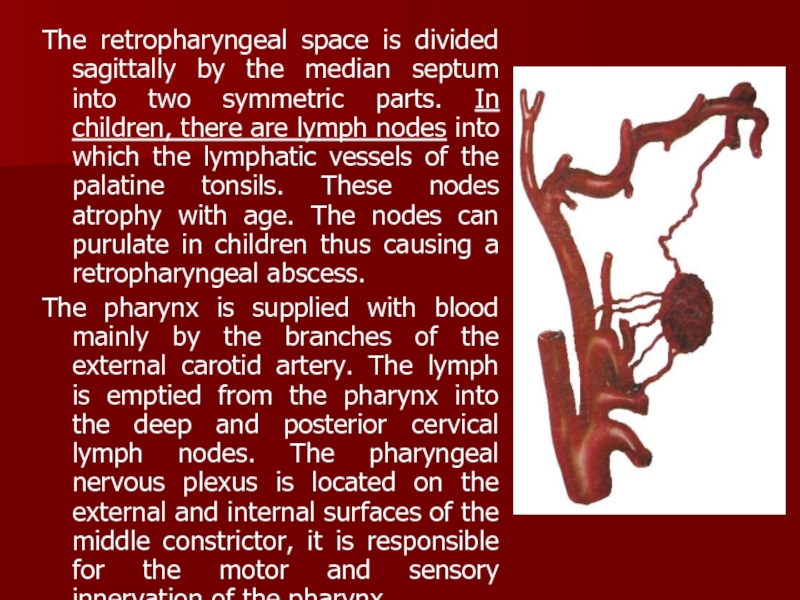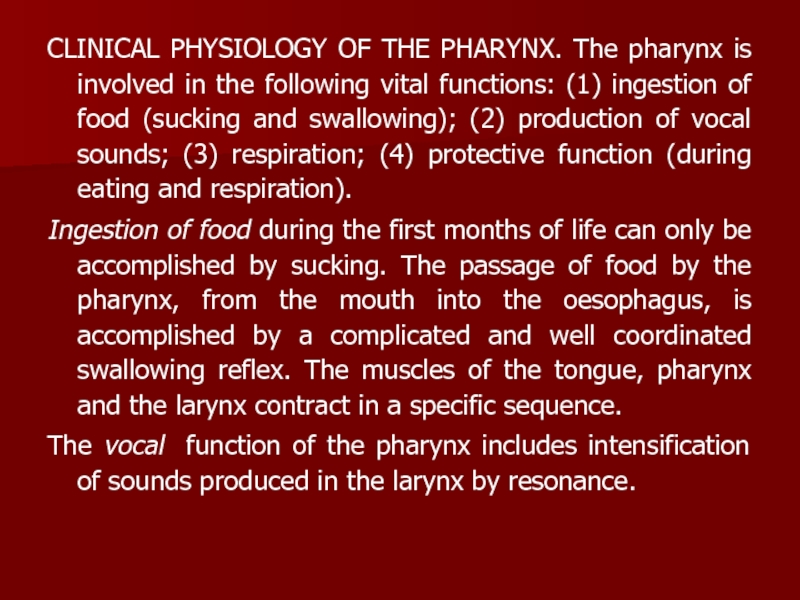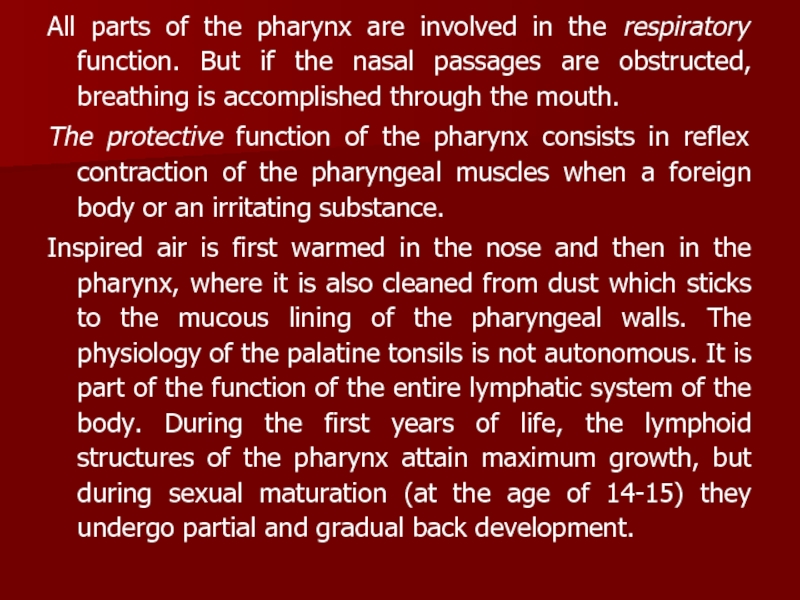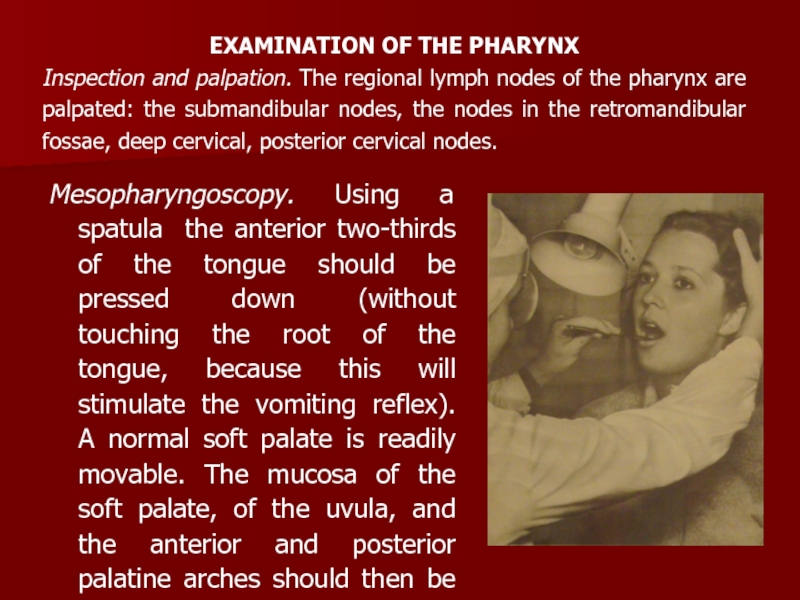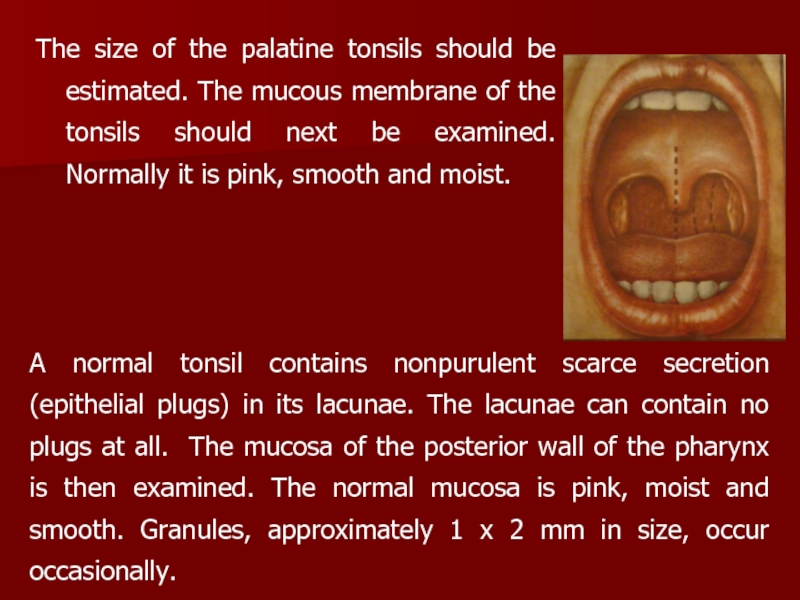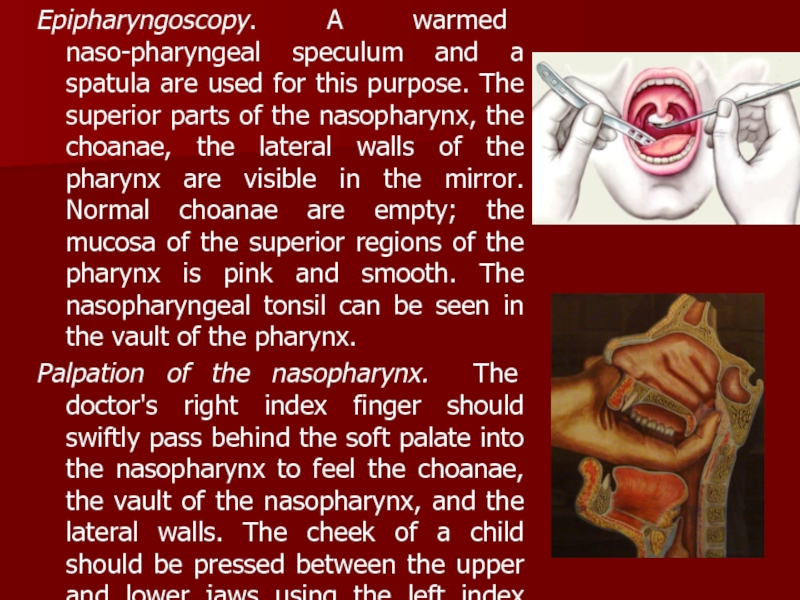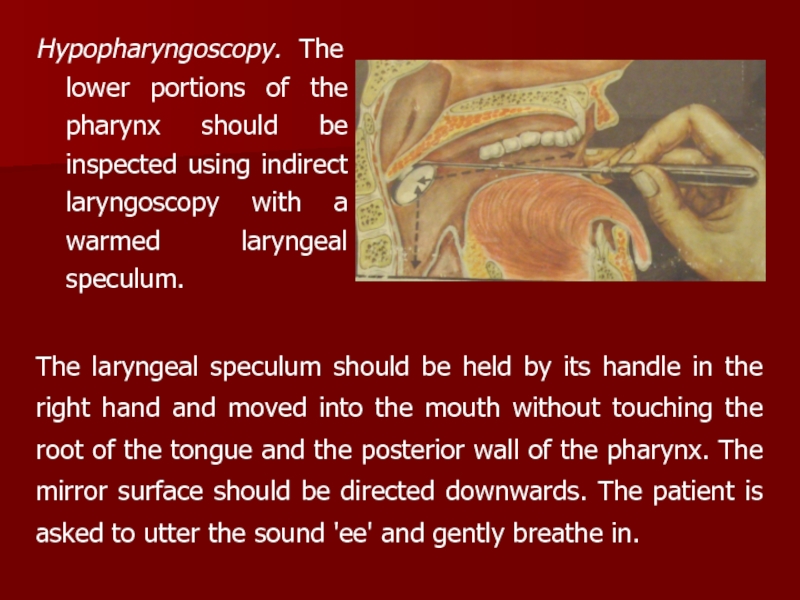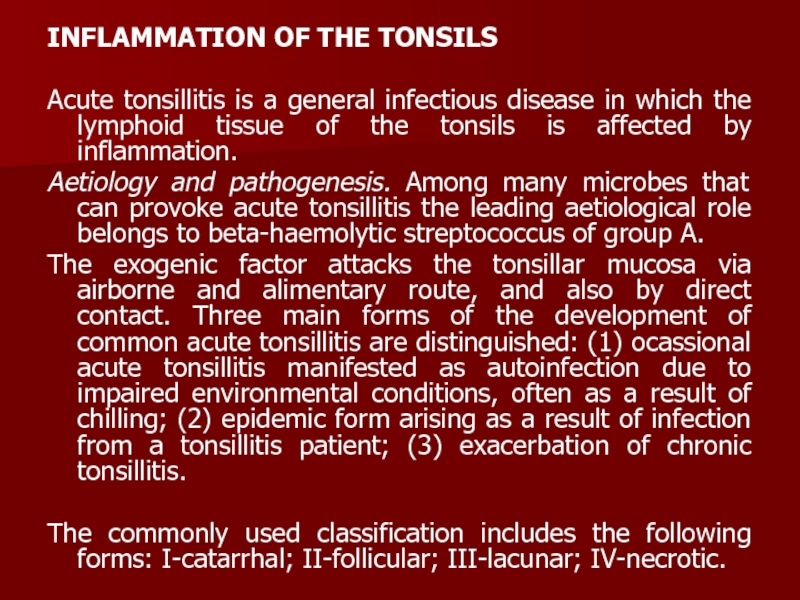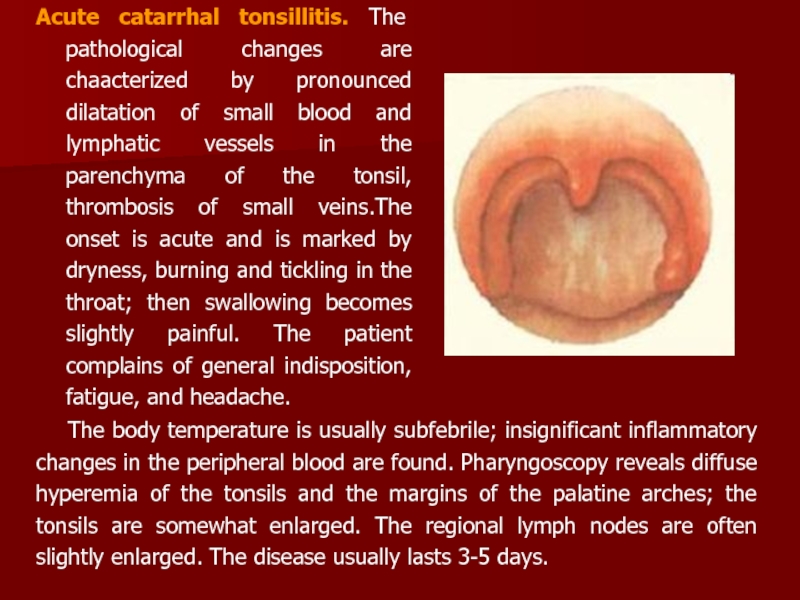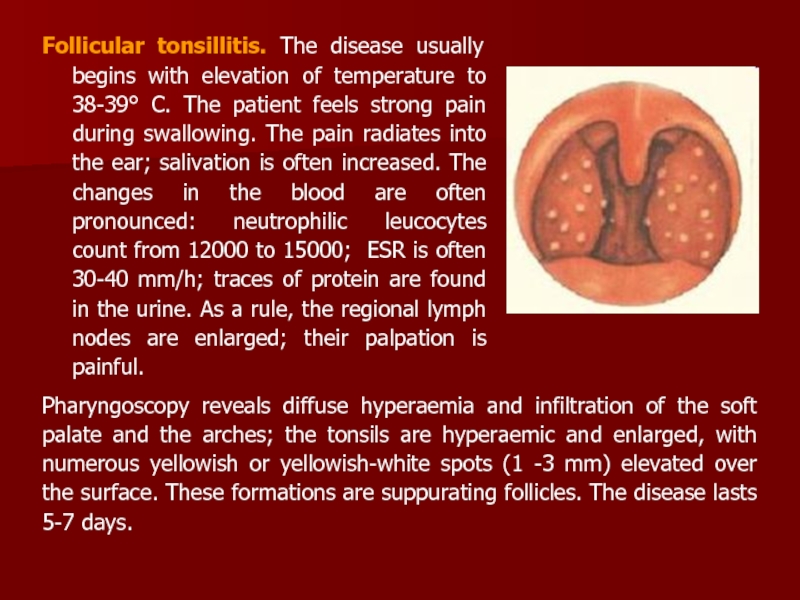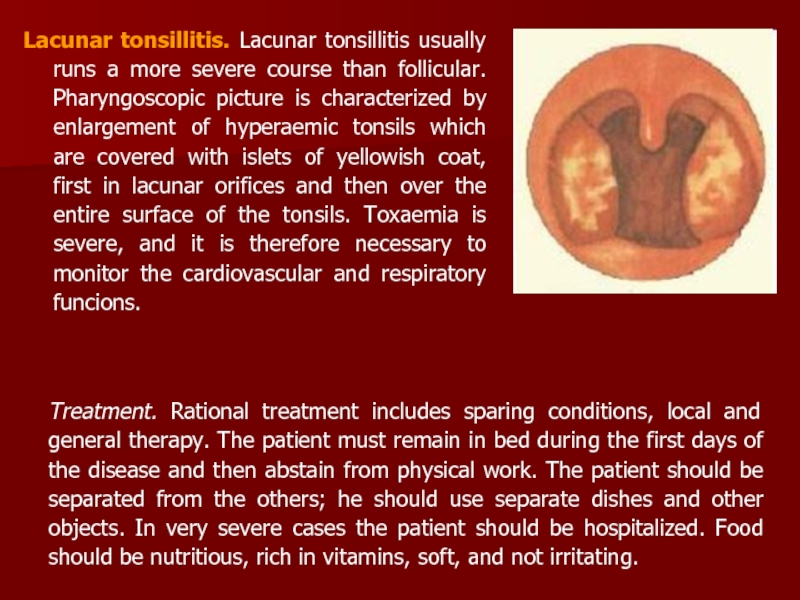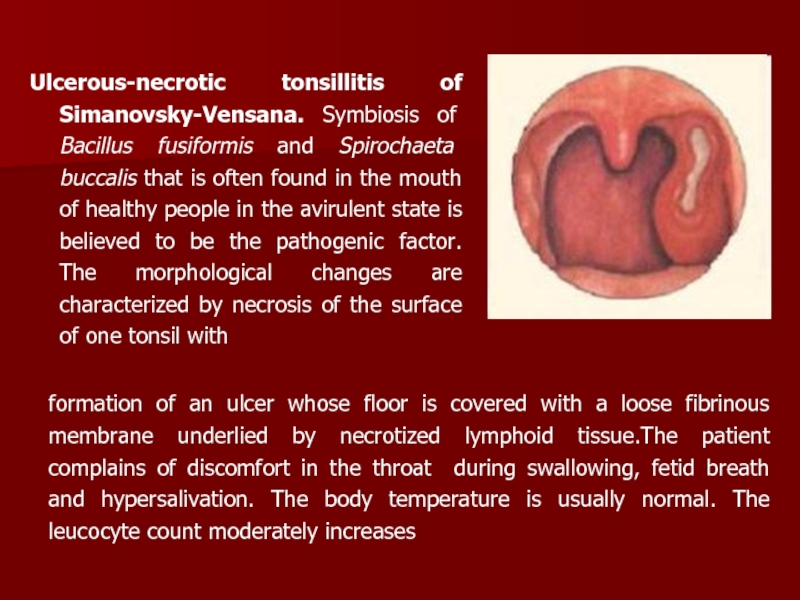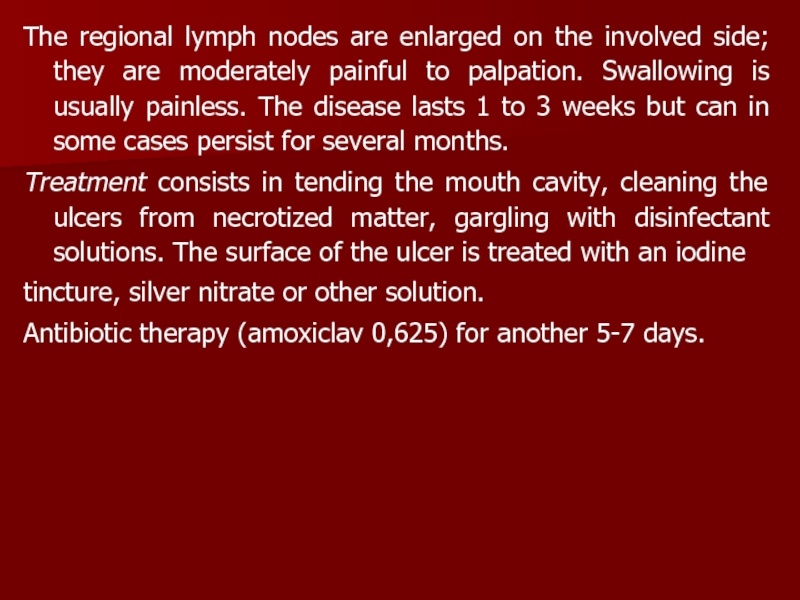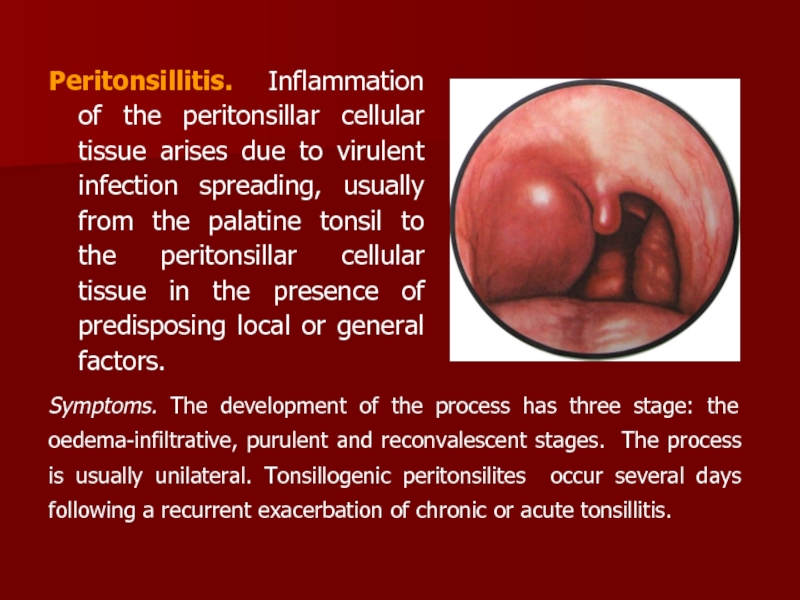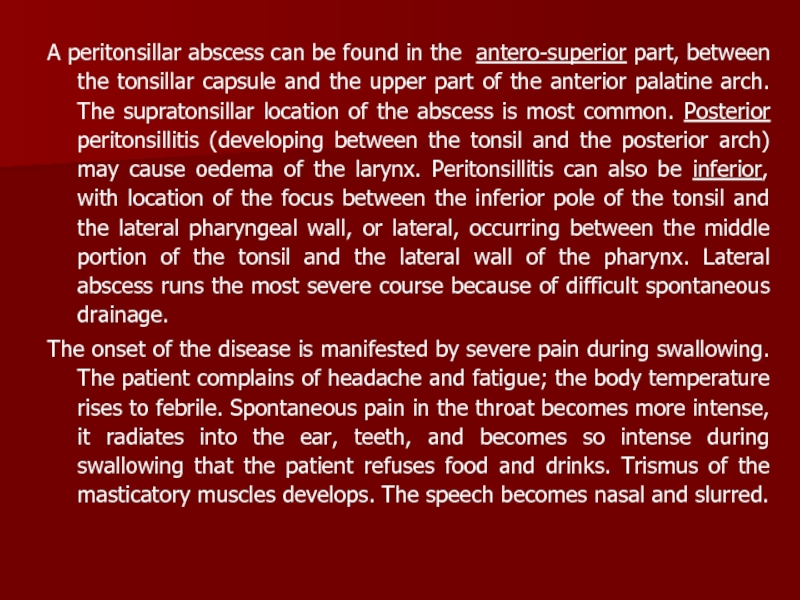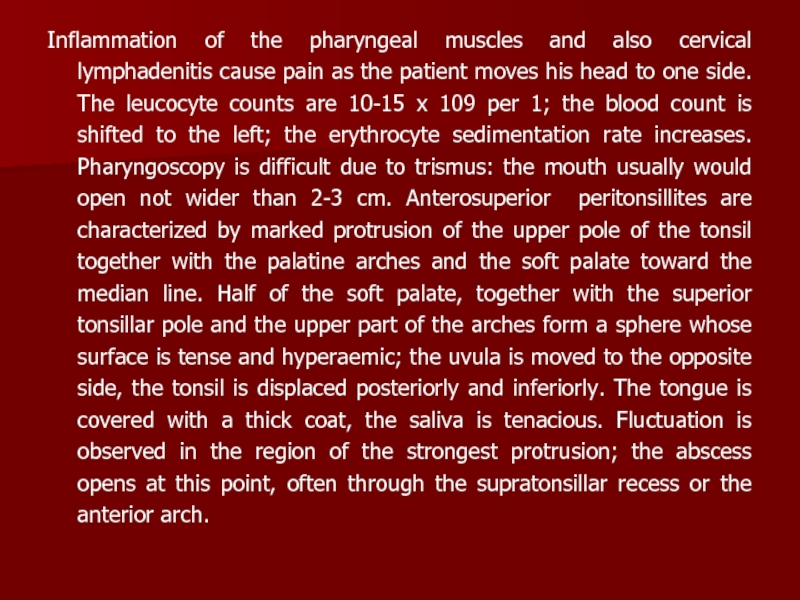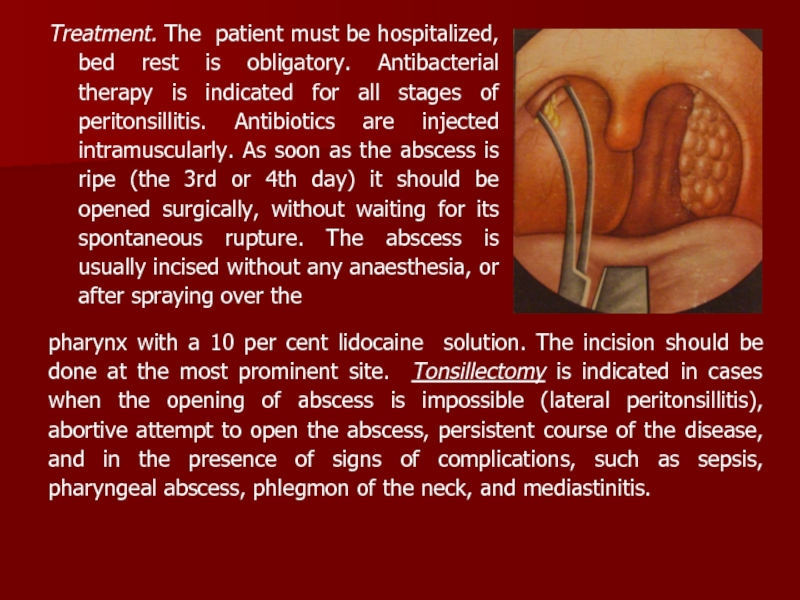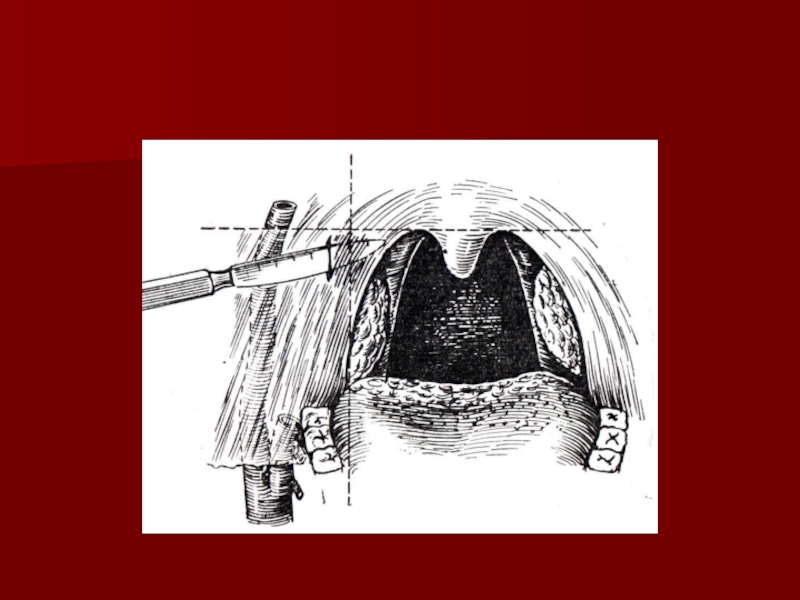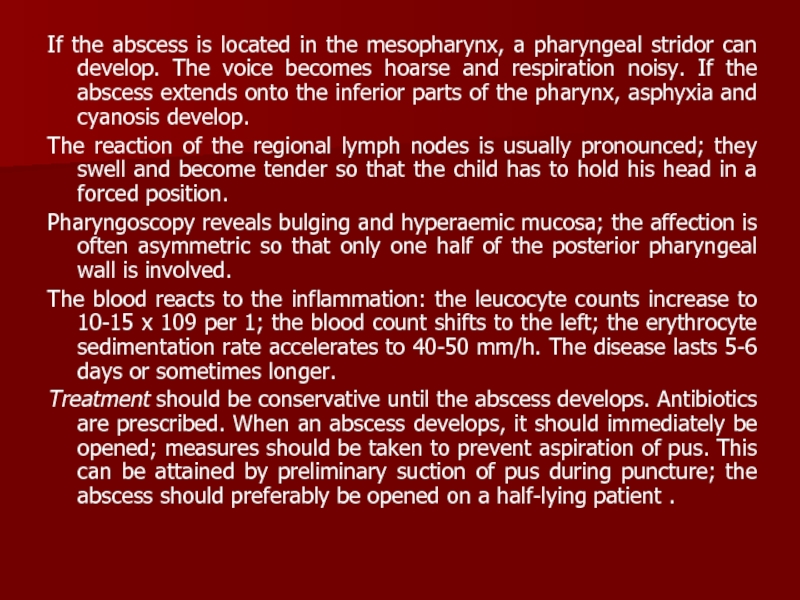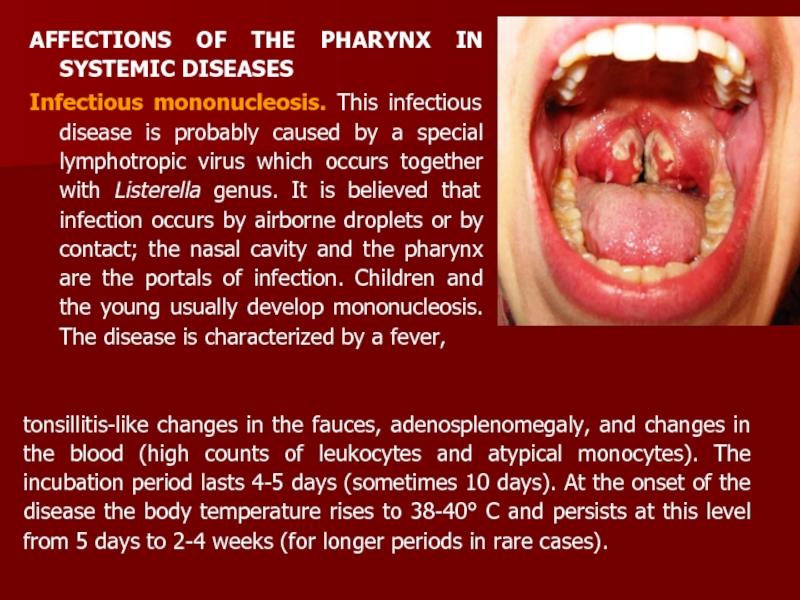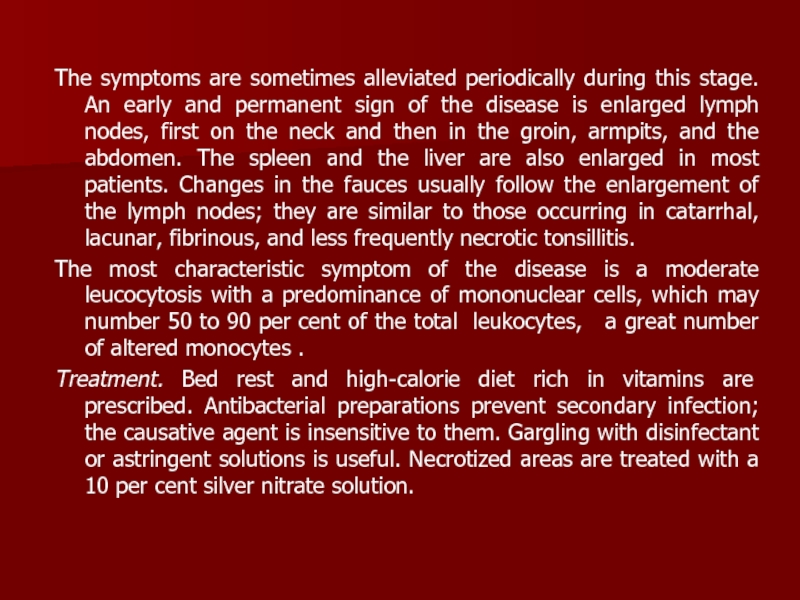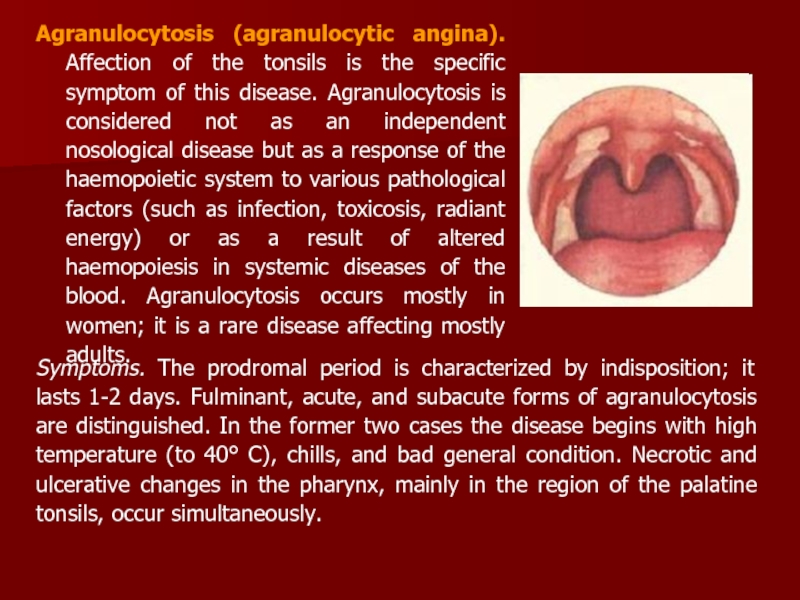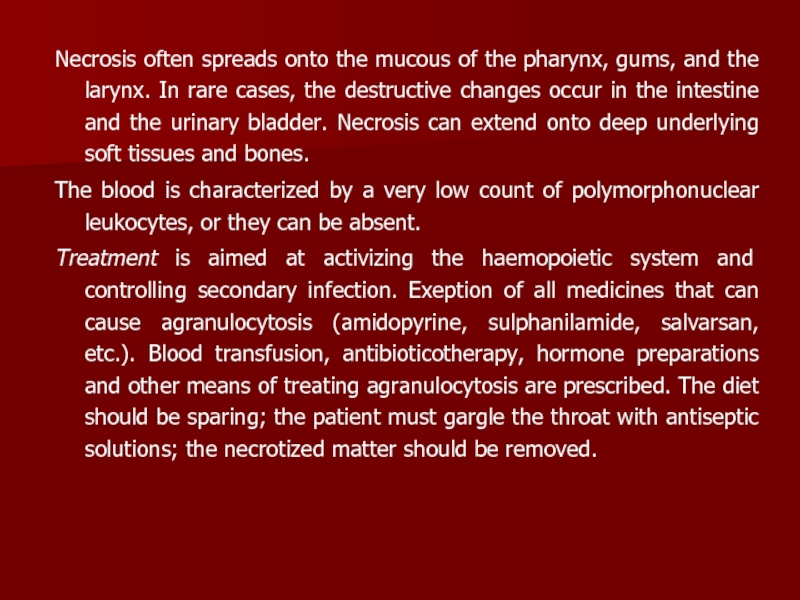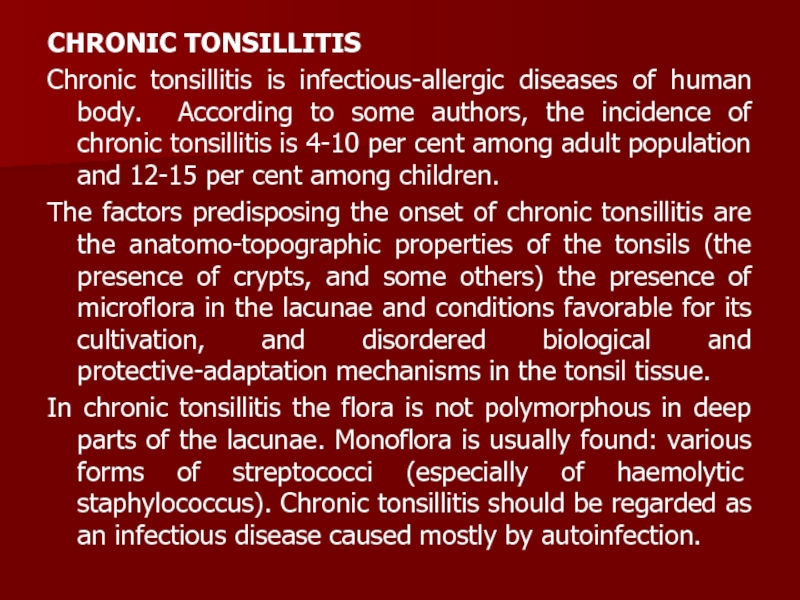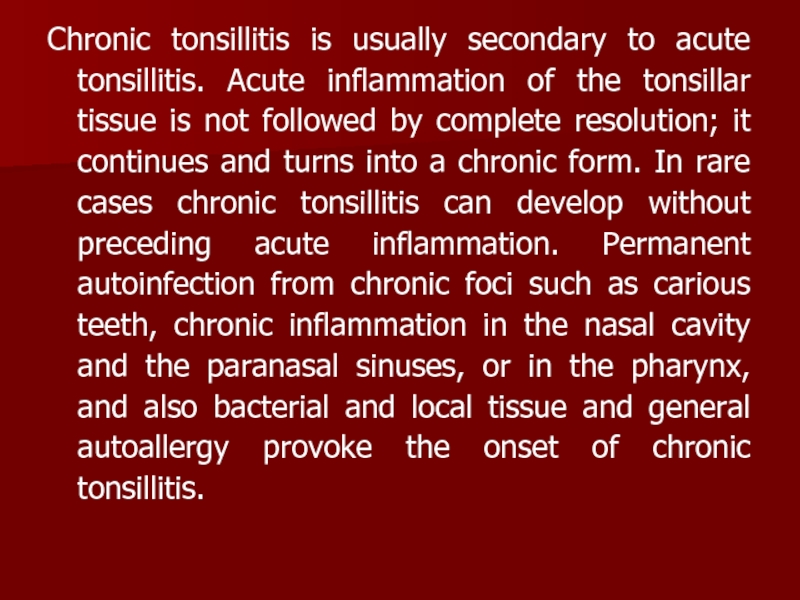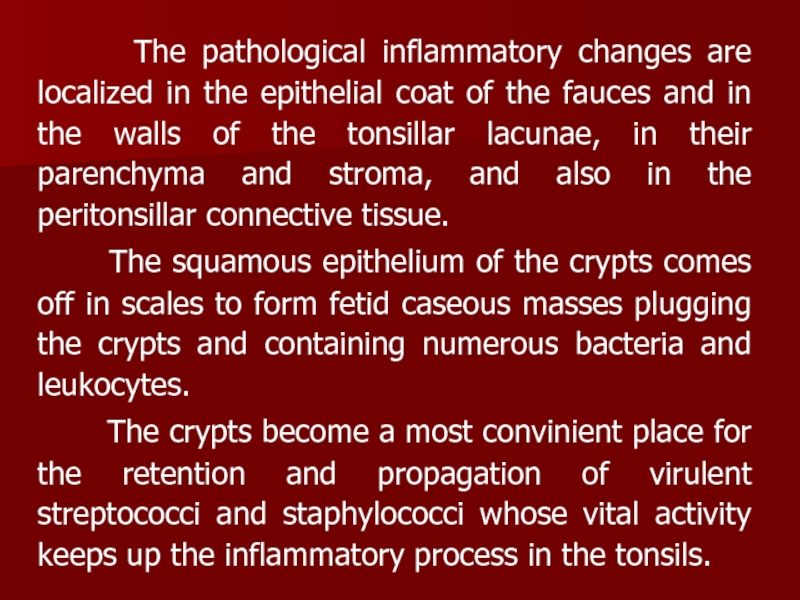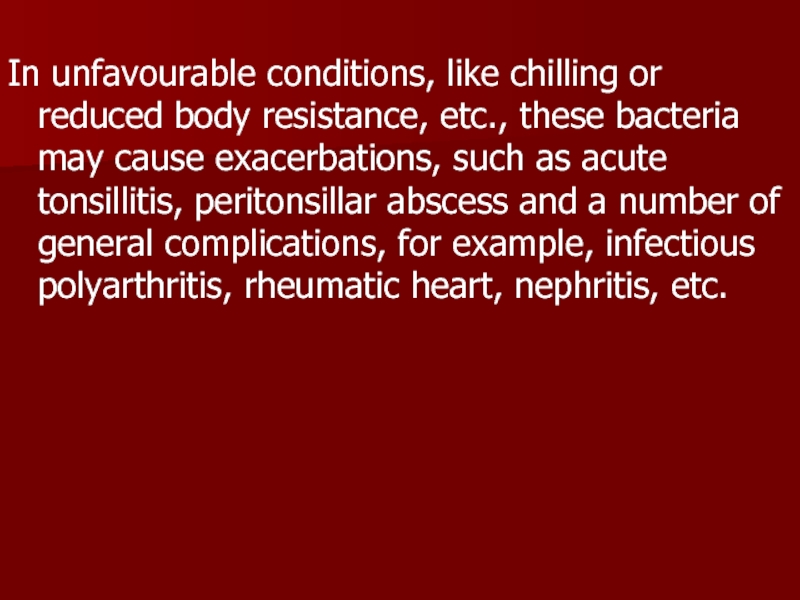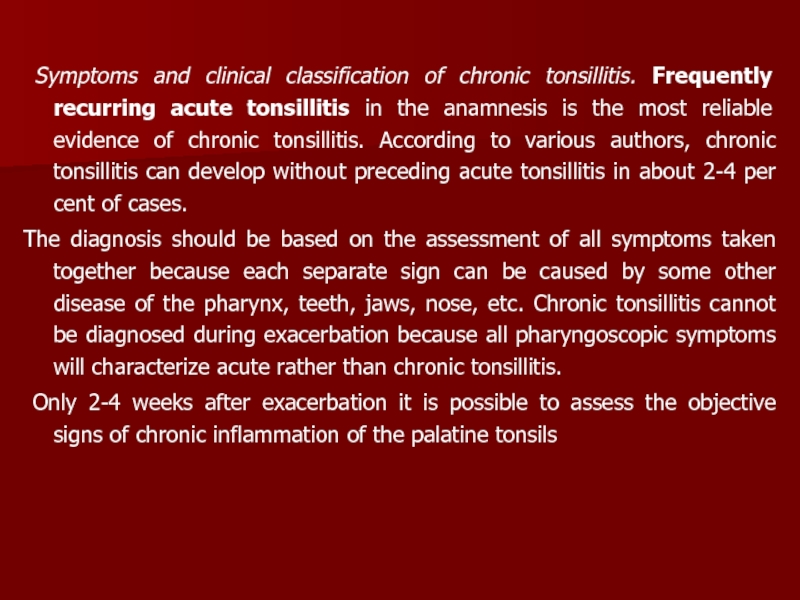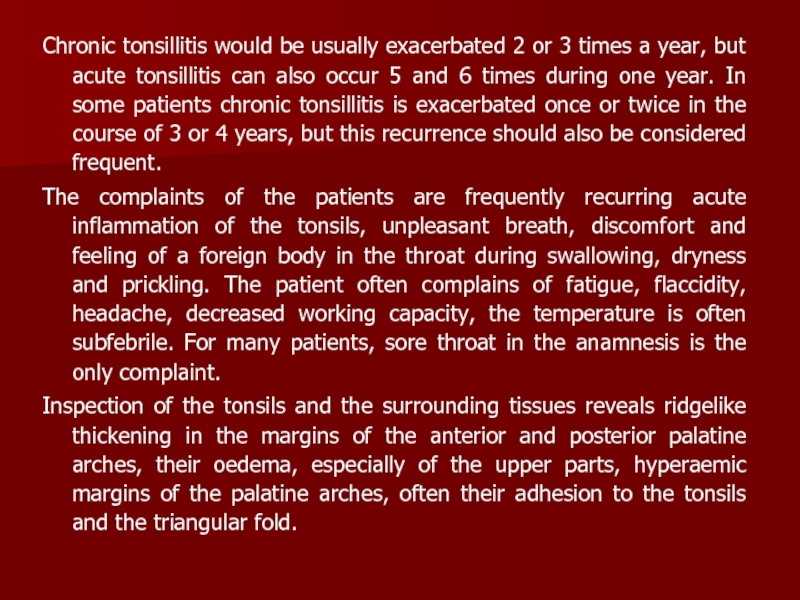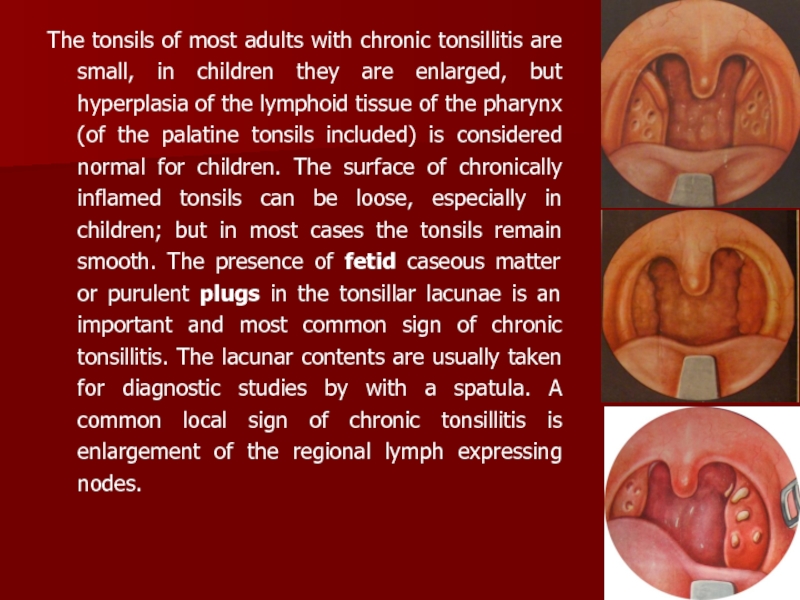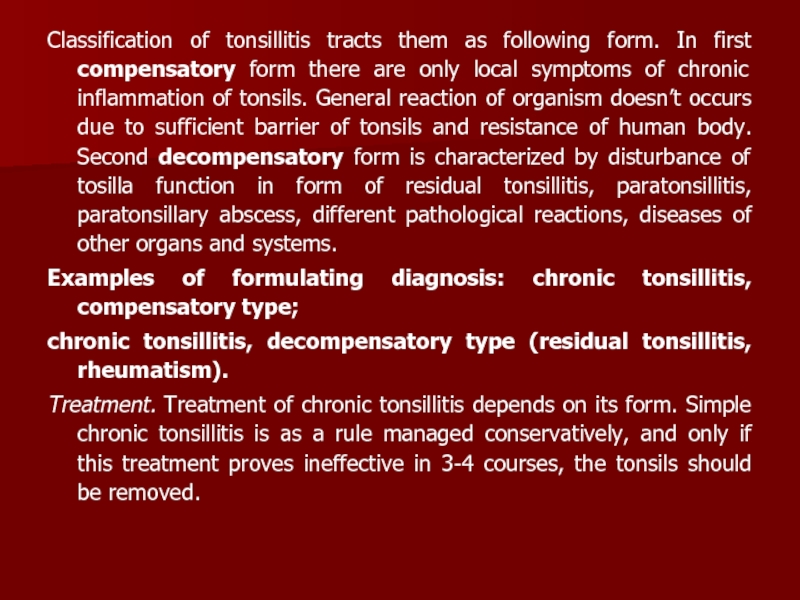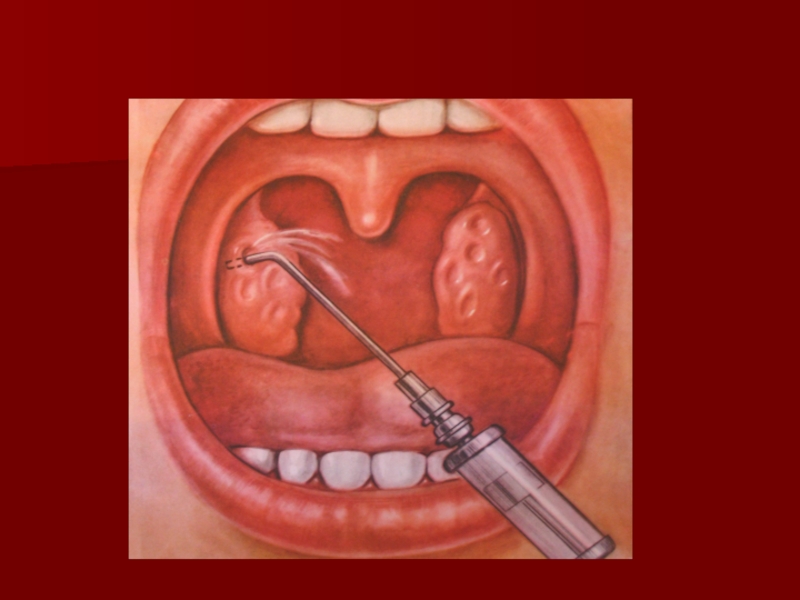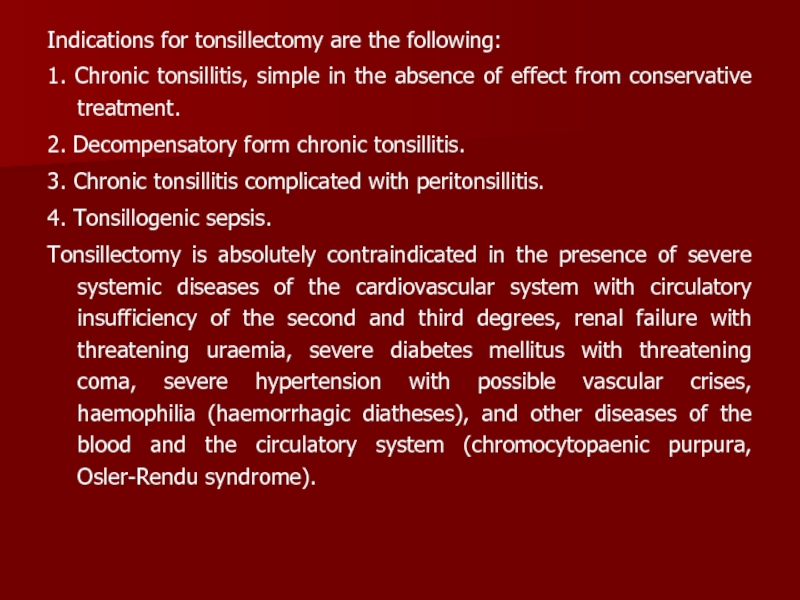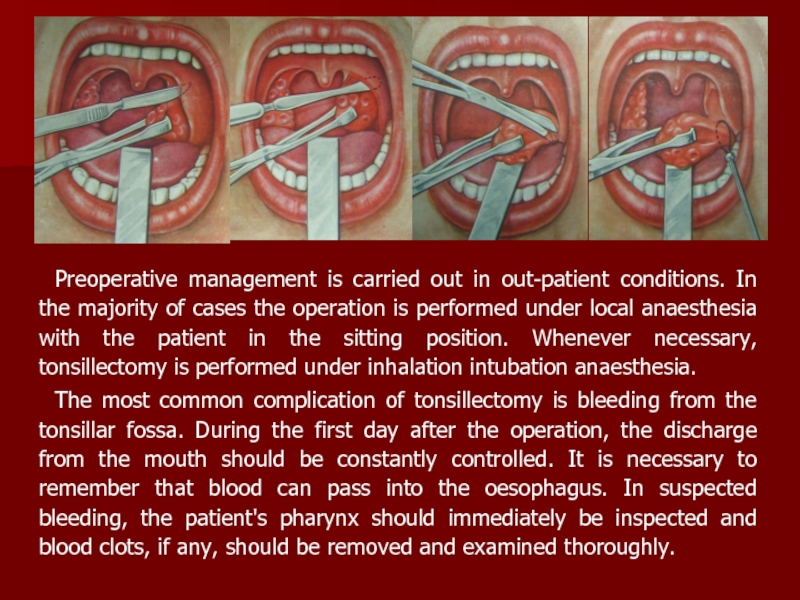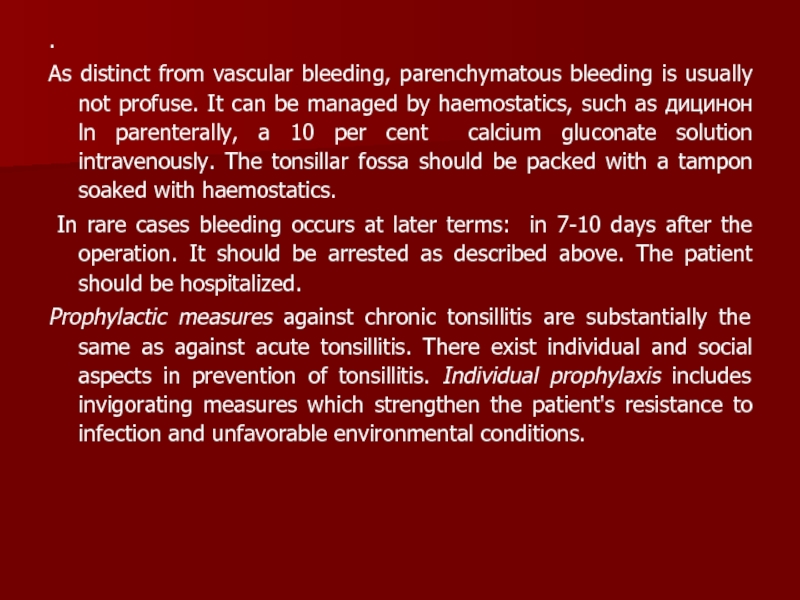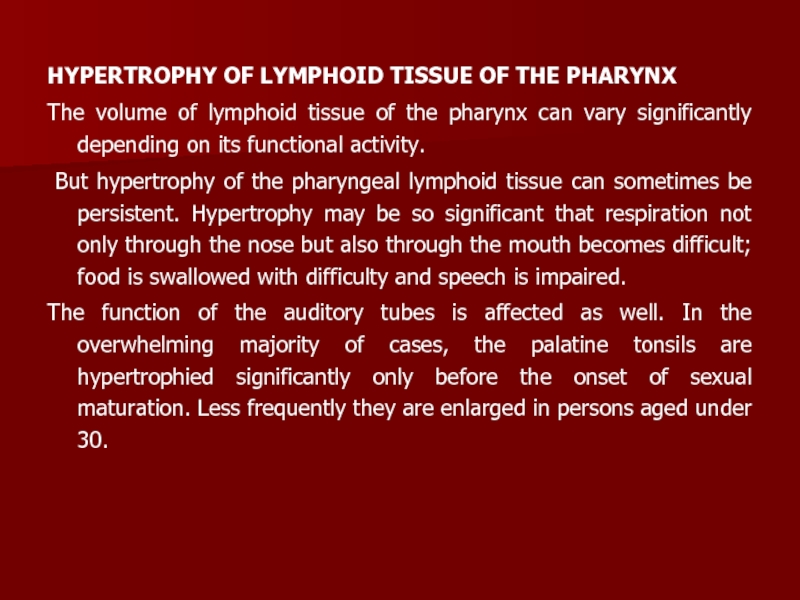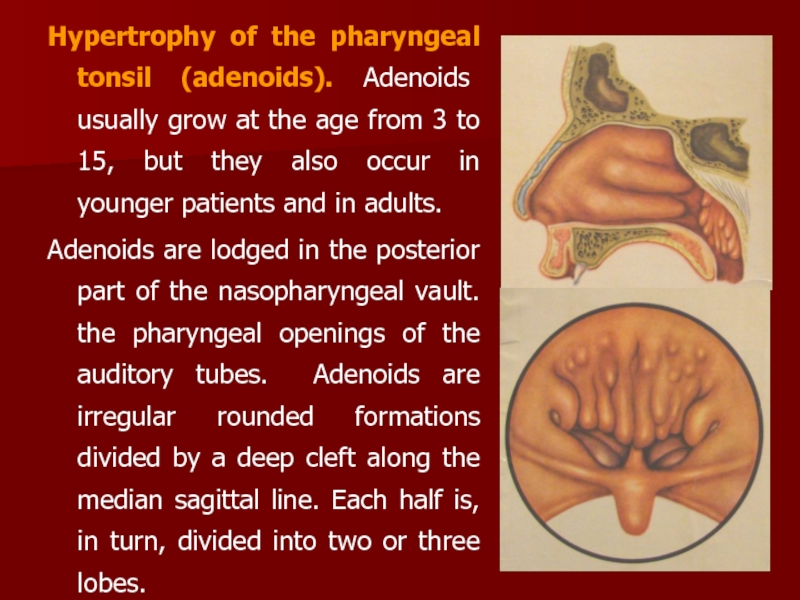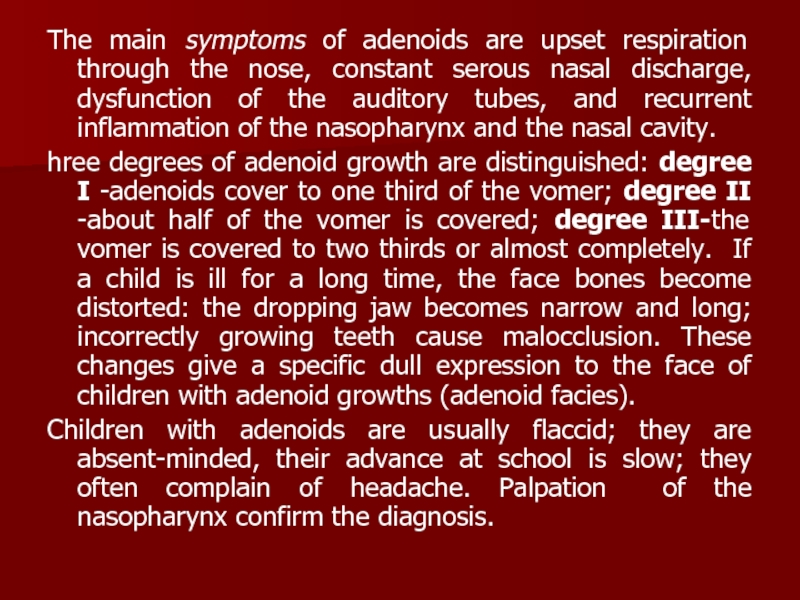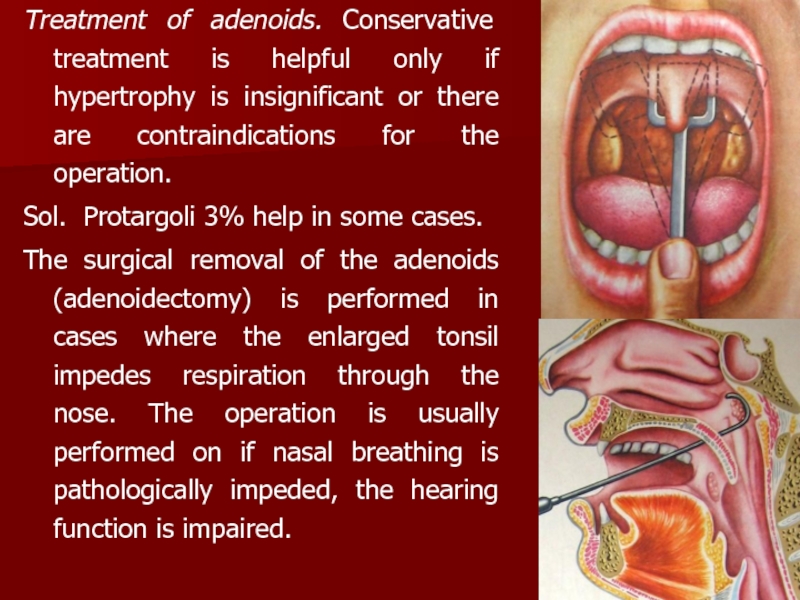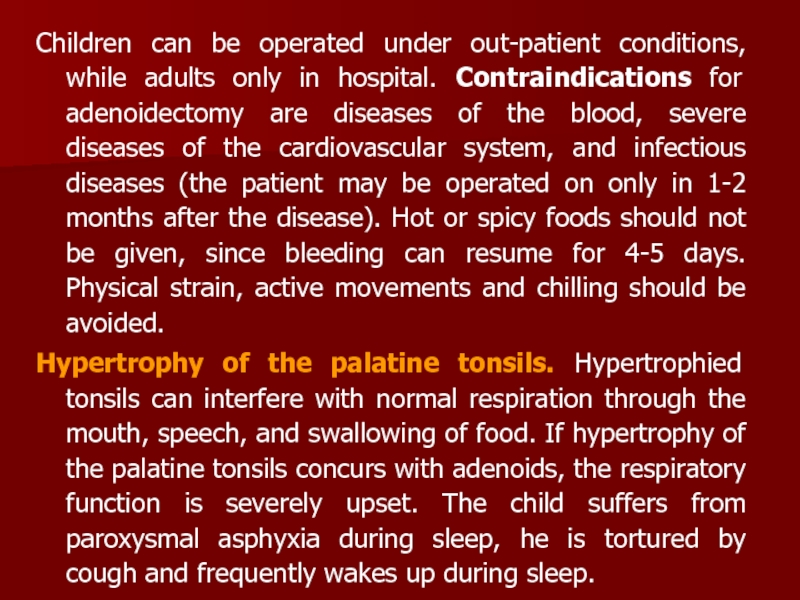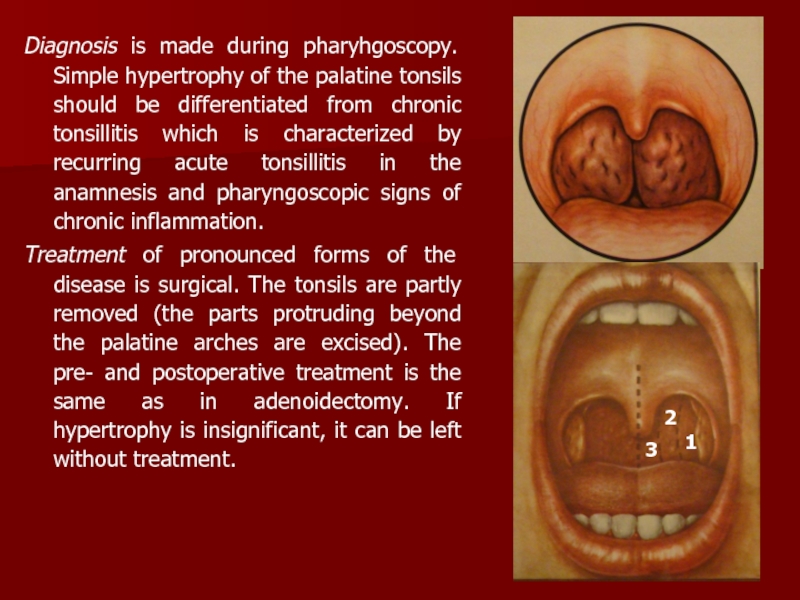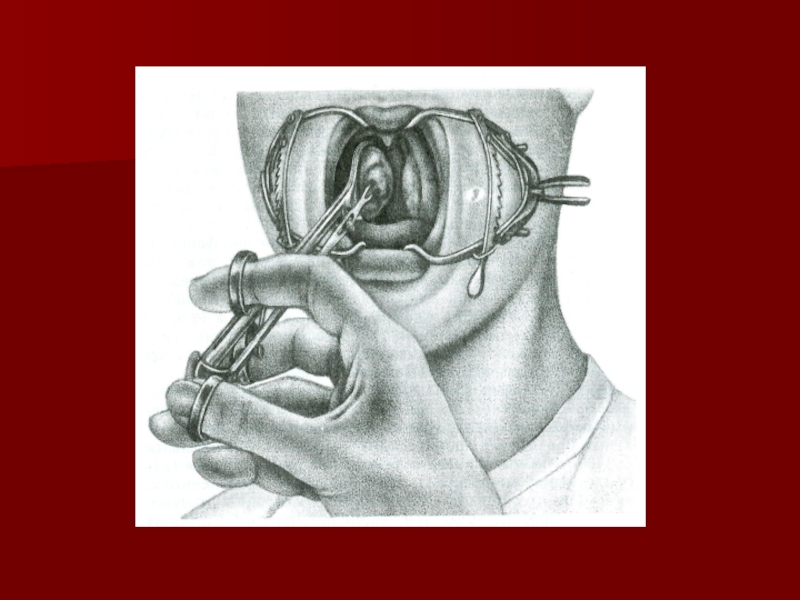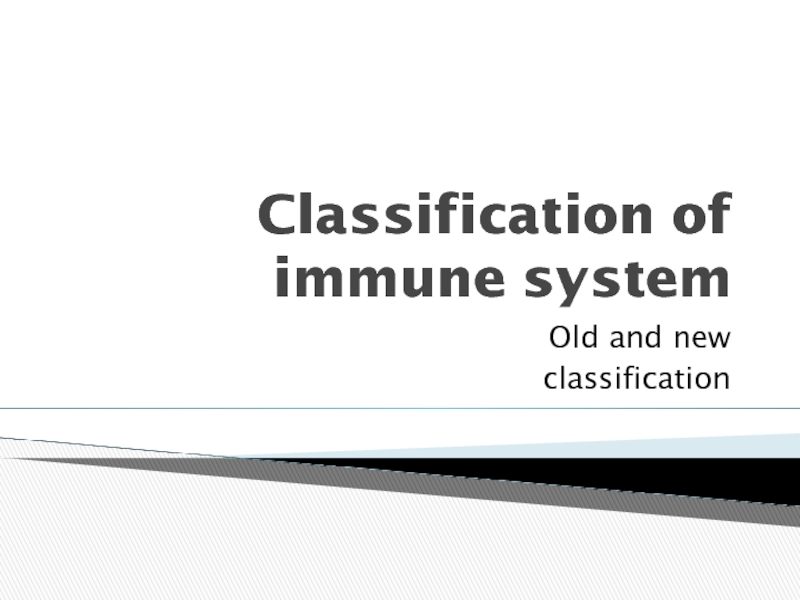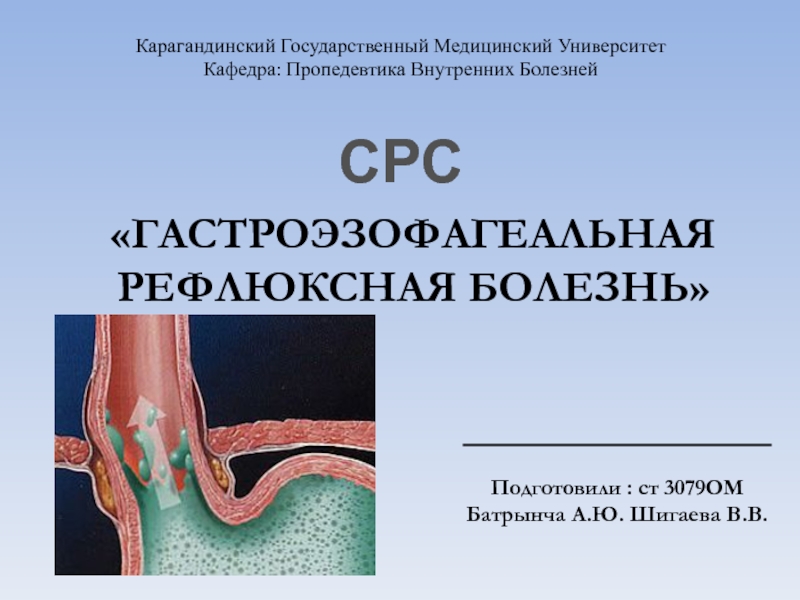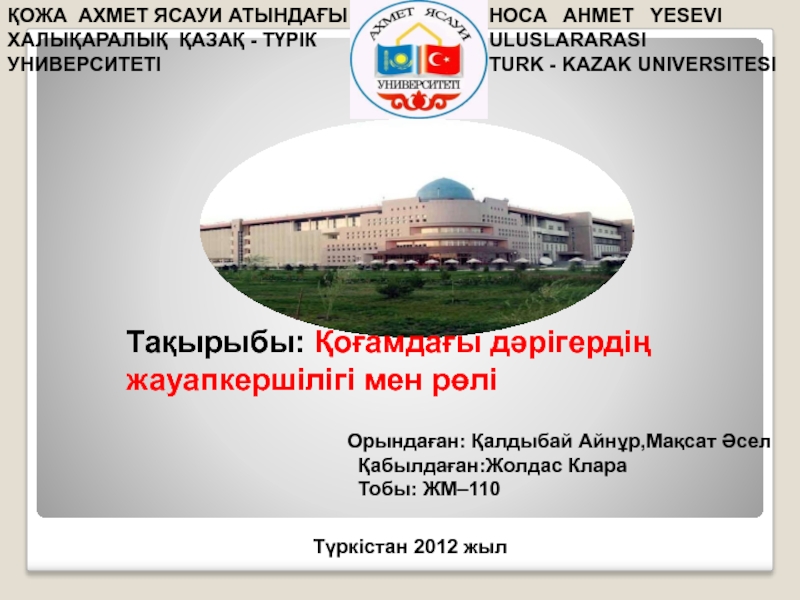Head of Otolaryngology
Department, professor V.I. Troyan
- Главная
- Разное
- Дизайн
- Бизнес и предпринимательство
- Аналитика
- Образование
- Развлечения
- Красота и здоровье
- Финансы
- Государство
- Путешествия
- Спорт
- Недвижимость
- Армия
- Графика
- Культурология
- Еда и кулинария
- Лингвистика
- Английский язык
- Астрономия
- Алгебра
- Биология
- География
- Детские презентации
- Информатика
- История
- Литература
- Маркетинг
- Математика
- Медицина
- Менеджмент
- Музыка
- МХК
- Немецкий язык
- ОБЖ
- Обществознание
- Окружающий мир
- Педагогика
- Русский язык
- Технология
- Физика
- Философия
- Химия
- Шаблоны, картинки для презентаций
- Экология
- Экономика
- Юриспруденция
Clinical anatomy, physiology and methods of examination of the pharynx презентация
Содержание
- 1. Clinical anatomy, physiology and methods of examination of the pharynx
- 2. The pharynx is a part of the
- 3. The nasopharynx performs only the respiratory function.
- 4. The oropharynx is the part of the
- 5. The histological structure of the lymphoid tissue
- 6. Located underneath the epithelium of the crypt
- 8. In the defense function of the tonsils
- 9. The former assure the informative function of
- 10. The laryngopharynx. The superior edge of the
- 11. The mucosa of the pharynx (its upper
- 12. The retropharyngeal space is divided sagittally by
- 13. CLINICAL PHYSIOLOGY OF THE PHARYNX. The pharynx
- 14. All parts of the pharynx are involved
- 15. Mesopharyngoscopy. Using a spatula the anterior two-thirds
- 16. The size of the palatine tonsils should
- 17. Epipharyngoscopy. A warmed naso-pharyngeal speculum and a
- 18. Hypopharyngoscopy. The lower portions of the pharynx
- 19. INFLAMMATION OF THE TONSILS Acute tonsillitis
- 20. Acute catarrhal tonsillitis. The pathological changes are
- 21. Follicular tonsillitis. The disease usually begins with
- 22. Lacunar tonsillitis. Lacunar tonsillitis usually runs a
- 23. Treatment includes also gargling with a warm
- 24. Ulcerous-necrotic tonsillitis of Simanovsky-Vensana. Symbiosis of
- 25. The regional lymph nodes are enlarged on
- 26. Peritonsillitis. Inflammation of the peritonsillar cellular tissue
- 27. A peritonsillar abscess can be found in
- 28. Inflammation of the pharyngeal muscles and also
- 29. Treatment. The patient must be hospitalized, bed
- 31. Retropharyngeal abscess. This is a purulent inflammation
- 32. If the abscess is located in the
- 33. AFFECTIONS OF THE PHARYNX IN SYSTEMIC DISEASES
- 34. The symptoms are sometimes alleviated periodically during
- 35. Agranulocytosis (agranulocytic angina). Affection of the tonsils
- 36. Necrosis often spreads onto the mucous of
- 37. CHRONIC TONSILLITIS Chronic tonsillitis is infectious-allergic diseases
- 38. Chronic tonsillitis is usually secondary to acute
- 39. The pathological inflammatory
- 40. In unfavourable conditions, like chilling or reduced
- 41. Symptoms and clinical classification of
- 42. Chronic tonsillitis would be usually exacerbated 2
- 43. The tonsils of most adults with chronic
- 44. Classification of tonsillitis tracts them as following
- 46. Indications for tonsillectomy are the following: 1.
- 47. Preoperative management is carried out in out-patient
- 48. . As distinct from vascular bleeding,
- 49. HYPERTROPHY OF LYMPHOID TISSUE OF THE
- 50. Hypertrophy of the pharyngeal tonsil (adenoids). Adenoids
- 51. The main symptoms of adenoids are upset
- 52. Treatment of adenoids. Conservative treatment is helpful
- 53. Children can be operated under out-patient conditions,
- 54. Diagnosis is made during pharyhgoscopy. Simple hypertrophy
Слайд 1Lecture №2 Clinical anatomy, physiology and methods of examination of the pharynx.
Слайд 2The pharynx is a part of the alimentary and respiratory tracts.
nasopharynx
oropharynx
laryngopharynx
Seven orifices open into the pharynx: two openings of the choanae and two openings of the auditory tubes are in the nasopharynx; the fauses opens into the oropharynx; and the inlet of the larynx and the oesophagus are found in the laryngopharynx.
Слайд 3The nasopharynx performs only the respiratory function. Two choanae are found
The pharyngeal tonsil is well developed only in children. During sexual maturation, the tonsil diminishes. The border between the superior and middle parts of the pharynx is an imaginary plane passing at the level of the hard palate.
nasopharynx
Слайд 4The oropharynx is the part of the pharynx through which air
In the soft palate itself a muscle is found which elevates the palate to bring it in contact with the posterior wall of the pharynx.
Contraction of this elevator muscle widens the lumen of the auditory tube. The other muscle of the soft palate strains and stretches the palate thus widening the opening of the auditory tube but narrowing its lumen in the rest of it.
Palatine tonsils are found in triangular recesses (tonsillar fossae) between the palatoglossal and palatopharyngeal arches.
Слайд 5The histological structure of the lymphoid tissue of the pharynx is
The outer surface of the tonsils is connected with the lateral wall of tht pharynx by a firm fibrous membrane called the capsule. The lacunae penetrate into the depth of the tonsil where they ramify.
Слайд 6Located underneath the epithelium of the crypt are diffuse lymphoid tissues
The basic cell element of the tonsil is the lymphocyte. T-lymphocytes (about 25%) appear in the palatine tonsils only after the formation of the thymus. They are mostly represented by T-helpers and T-suppressors. A small number of T-helpers located in the secondary follicle. In addition the tonsils also have plasmatic cells, the so called normal killers; immunoglobuline synthesizing cells of the classes G, A, M, U, D, small lymphocytes with a relatively massive nucleus – the carrier of encoded information. These are the so called memory cells.
Слайд 8 In the defense function of the tonsils an important role is
The structure of the palatine tonsils foresees the continuous prolonged contact of the antigens with the lymphoid cells which migrate into the lacunar lumen; a more intense migration of lymphocytes takes place in regions where the connective tissue is absent.
This contact in itself helps the lymphoid cells in obtaining antigenic information. With the formation of clone cells in tonsils tissues which are specific in relation to the given antigen.
Слайд 9The former assure the informative function of the tonsil tissue, carried
This function enables the sustainment of the normal mictoflora.
In such a manner, the tonsils, mainly, are responsible for carrying out 3 biologically important functions:
defensive, informative and sustenance of the bacteriological homeostasis.
The lingual tonsil (IV) is located on the root of the tongue.. All these tonsils are called the throat ring (Pirogov-Waldeyer tonsillar ring).
Слайд 10The laryngopharynx. The superior edge of the epiglottis and the root
Слайд 11The mucosa of the pharynx (its upper portion) is covered with
Слайд 12The retropharyngeal space is divided sagittally by the median septum into
The pharynx is supplied with blood mainly by the branches of the external carotid artery. The lymph is emptied from the pharynx into the deep and posterior cervical lymph nodes. The pharyngeal nervous plexus is located on the external and internal surfaces of the middle constrictor, it is responsible for the motor and sensory innervation of the pharynx.
Слайд 13CLINICAL PHYSIOLOGY OF THE PHARYNX. The pharynx is involved in the
Ingestion of food during the first months of life can only be accomplished by sucking. The passage of food by the pharynx, from the mouth into the oesophagus, is accomplished by a complicated and well coordinated swallowing reflex. The muscles of the tongue, pharynx and the larynx contract in a specific sequence.
The vocal function of the pharynx includes intensification of sounds produced in the larynx by resonance.
Слайд 14All parts of the pharynx are involved in the respiratory function.
The protective function of the pharynx consists in reflex contraction of the pharyngeal muscles when a foreign body or an irritating substance.
Inspired air is first warmed in the nose and then in the pharynx, where it is also cleaned from dust which sticks to the mucous lining of the pharyngeal walls. The physiology of the palatine tonsils is not autonomous. It is part of the function of the entire lymphatic system of the body. During the first years of life, the lymphoid structures of the pharynx attain maximum growth, but during sexual maturation (at the age of 14-15) they undergo partial and gradual back development.
Слайд 15Mesopharyngoscopy. Using a spatula the anterior two-thirds of the tongue should
EXAMINATION OF THE PHARYNX
Inspection and palpation. The regional lymph nodes of the pharynx are palpated: the submandibular nodes, the nodes in the retromandibular fossae, deep cervical, posterior cervical nodes.
Слайд 16The size of the palatine tonsils should be estimated. The mucous
A normal tonsil contains nonpurulent scarce secretion (epithelial plugs) in its lacunae. The lacunae can contain no plugs at all. The mucosa of the posterior wall of the pharynx is then examined. The normal mucosa is pink, moist and smooth. Granules, approximately 1 x 2 mm in size, occur occasionally.
Слайд 17Epipharyngoscopy. A warmed naso-pharyngeal speculum and a spatula are used for
Palpation of the nasopharynx. The doctor's right index finger should swiftly pass behind the soft palate into the nasopharynx to feel the choanae, the vault of the nasopharynx, and the lateral walls. The cheek of a child should be pressed between the upper and lower jaws using the left index finger.
Слайд 18Hypopharyngoscopy. The lower portions of the pharynx should be inspected using
The laryngeal speculum should be held by its handle in the right hand and moved into the mouth without touching the root of the tongue and the posterior wall of the pharynx. The mirror surface should be directed downwards. The patient is asked to utter the sound 'ee' and gently breathe in.
Слайд 19INFLAMMATION OF THE TONSILS
Acute tonsillitis is a general infectious disease in
Aetiology and pathogenesis. Among many microbes that can provoke acute tonsillitis the leading aetiological role belongs to beta-haemolytic streptococcus of group A.
The exogenic factor attacks the tonsillar mucosa via airborne and alimentary route, and also by direct contact. Three main forms of the development of common acute tonsillitis are distinguished: (1) ocassional acute tonsillitis manifested as autoinfection due to impaired environmental conditions, often as a result of chilling; (2) epidemic form arising as a result of infection from a tonsillitis patient; (3) exacerbation of chronic tonsillitis.
The commonly used classification includes the following forms: I-catarrhal; II-follicular; III-lacunar; IV-necrotic.
Слайд 20Acute catarrhal tonsillitis. The pathological changes are chaacterized by pronounced dilatation
The body temperature is usually subfebrile; insignificant inflammatory changes in the peripheral blood are found. Pharyngoscopy reveals diffuse hyperemia of the tonsils and the margins of the palatine arches; the tonsils are somewhat enlarged. The regional lymph nodes are often slightly enlarged. The disease usually lasts 3-5 days.
Слайд 21Follicular tonsillitis. The disease usually begins with elevation of temperature to
Pharyngoscopy reveals diffuse hyperaemia and infiltration of the soft palate and the arches; the tonsils are hyperaemic and enlarged, with numerous yellowish or yellowish-white spots (1 -3 mm) elevated over the surface. These formations are suppurating follicles. The disease lasts 5-7 days.
Слайд 22Lacunar tonsillitis. Lacunar tonsillitis usually runs a more severe course than
Treatment. Rational treatment includes sparing conditions, local and general therapy. The patient must remain in bed during the first days of the disease and then abstain from physical work. The patient should be separated from the others; he should use separate dishes and other objects. In very severe cases the patient should be hospitalized. Food should be nutritious, rich in vitamins, soft, and not irritating.
Слайд 23Treatment includes also gargling with a warm solution of hydrocarbonate, furacilin.
The choice of antibacterial preparations depends on the gravity of the disease and the danger of complications. The antibiotic is administered usually for 5 days, which is, as a rule, sufficient to normalize body temperature and to improve the patient's condition. In order to eliminate reliably the infectious focus, it is necessary to continue the antibiotic therapy (amoxil 0,5 or amoxiclav 0,625) for another 5-7 days. Desensitizing preparations such as loratadin, ksisal etc. are recommended.
Слайд 24
Ulcerous-necrotic tonsillitis of Simanovsky-Vensana. Symbiosis of Bacillus fusiformis and Spirochaeta buccalis
formation of an ulcer whose floor is covered with a loose fibrinous membrane underlied by necrotized lymphoid tissue.The patient complains of discomfort in the throat during swallowing, fetid breath and hypersalivation. The body temperature is usually normal. The leucocyte count moderately increases
Слайд 25The regional lymph nodes are enlarged on the involved side; they
Treatment consists in tending the mouth cavity, cleaning the ulcers from necrotized matter, gargling with disinfectant solutions. The surface of the ulcer is treated with an iodine
tincture, silver nitrate or other solution.
Antibiotic therapy (amoxiclav 0,625) for another 5-7 days.
Слайд 26Peritonsillitis. Inflammation of the peritonsillar cellular tissue arises due to virulent
Symptoms. The development of the process has three stage: the oedema-infiltrative, purulent and reconvalescent stages. The process is usually unilateral. Tonsillogenic peritonsilites occur several days following a recurrent exacerbation of chronic or acute tonsillitis.
Слайд 27A peritonsillar abscess can be found in the antero-superior part, between
The onset of the disease is manifested by severe pain during swallowing. The patient complains of headache and fatigue; the body temperature rises to febrile. Spontaneous pain in the throat becomes more intense, it radiates into the ear, teeth, and becomes so intense during swallowing that the patient refuses food and drinks. Trismus of the masticatory muscles develops. The speech becomes nasal and slurred.
Слайд 28Inflammation of the pharyngeal muscles and also cervical lymphadenitis cause pain
Слайд 29Treatment. The patient must be hospitalized, bed rest is obligatory. Antibacterial
pharynx with a 10 per cent lidocaine solution. The incision should be done at the most prominent site. Tonsillectomy is indicated in cases when the opening of abscess is impossible (lateral peritonsillitis), abortive attempt to open the abscess, persistent course of the disease, and in the presence of signs of complications, such as sepsis, pharyngeal abscess, phlegmon of the neck, and mediastinitis.
Слайд 31Retropharyngeal abscess. This is a purulent inflammation of the lymph nodes
The first symptoms are usually pain in the throat during swallowing and impeded respiration. The child refuses food, becomes restless and often cries; sleep is deranged. The temperature rises to 38-39° C. If the abscess is found in the nasopharynx, respiration through the nose becomes difficult, speech is nasal and the voice timbre dull.
Слайд 32If the abscess is located in the mesopharynx, a pharyngeal stridor
The reaction of the regional lymph nodes is usually pronounced; they swell and become tender so that the child has to hold his head in a forced position.
Pharyngoscopy reveals bulging and hyperaemic mucosa; the affection is often asymmetric so that only one half of the posterior pharyngeal wall is involved.
The blood reacts to the inflammation: the leucocyte counts increase to 10-15 x 109 per 1; the blood count shifts to the left; the erythrocyte sedimentation rate accelerates to 40-50 mm/h. The disease lasts 5-6 days or sometimes longer.
Treatment should be conservative until the abscess develops. Antibiotics are prescribed. When an abscess develops, it should immediately be opened; measures should be taken to prevent aspiration of pus. This can be attained by preliminary suction of pus during puncture; the abscess should preferably be opened on a half-lying patient .
Слайд 33AFFECTIONS OF THE PHARYNX IN SYSTEMIC DISEASES
Infectious mononucleosis. This infectious
tonsillitis-like changes in the fauces, adenosplenomegaly, and changes in the blood (high counts of leukocytes and atypical monocytes). The incubation period lasts 4-5 days (sometimes 10 days). At the onset of the disease the body temperature rises to 38-40° C and persists at this level from 5 days to 2-4 weeks (for longer periods in rare cases).
Слайд 34The symptoms are sometimes alleviated periodically during this stage. An early
The most characteristic symptom of the disease is a moderate leucocytosis with a predominance of mononuclear cells, which may number 50 to 90 per cent of the total leukocytes, a great number of altered monocytes .
Treatment. Bed rest and high-calorie diet rich in vitamins are prescribed. Antibacterial preparations prevent secondary infection; the causative agent is insensitive to them. Gargling with disinfectant or astringent solutions is useful. Necrotized areas are treated with a 10 per cent silver nitrate solution.
Слайд 35Agranulocytosis (agranulocytic angina). Affection of the tonsils is the specific symptom
Symptoms. The prodromal period is characterized by indisposition; it lasts 1-2 days. Fulminant, acute, and subacute forms of agranulocytosis are distinguished. In the former two cases the disease begins with high temperature (to 40° C), chills, and bad general condition. Necrotic and ulcerative changes in the pharynx, mainly in the region of the palatine tonsils, occur simultaneously.
Слайд 36Necrosis often spreads onto the mucous of the pharynx, gums, and
The blood is characterized by a very low count of polymorphonuclear leukocytes, or they can be absent.
Treatment is aimed at activizing the haemopoietic system and controlling secondary infection. Exeption of all medicines that can cause agranulocytosis (amidopyrine, sulphanilamide, salvarsan, etc.). Blood transfusion, antibioticotherapy, hormone preparations and other means of treating agranulocytosis are prescribed. The diet should be sparing; the patient must gargle the throat with antiseptic solutions; the necrotized matter should be removed.
Слайд 37CHRONIC TONSILLITIS
Chronic tonsillitis is infectious-allergic diseases of human body. According to
The factors predisposing the onset of chronic tonsillitis are the anatomo-topographic properties of the tonsils (the presence of crypts, and some others) the presence of microflora in the lacunae and conditions favorable for its cultivation, and disordered biological and protective-adaptation mechanisms in the tonsil tissue.
In chronic tonsillitis the flora is not polymorphous in deep parts of the lacunae. Monoflora is usually found: various forms of streptococci (especially of haemolytic staphylococcus). Chronic tonsillitis should be regarded as an infectious disease caused mostly by autoinfection.
Слайд 38Chronic tonsillitis is usually secondary to acute tonsillitis. Acute inflammation of
Слайд 39 The pathological inflammatory changes are localized in
The squamous epithelium of the crypts comes off in scales to form fetid caseous masses plugging the crypts and containing numerous bacteria and leukocytes.
The crypts become a most convinient place for the retention and propagation of virulent streptococci and staphylococci whose vital activity keeps up the inflammatory process in the tonsils.
Слайд 40In unfavourable conditions, like chilling or reduced body resistance, etc., these
Слайд 41
Symptoms and clinical classification of chronic tonsillitis. Frequently recurring acute
The diagnosis should be based on the assessment of all symptoms taken together because each separate sign can be caused by some other disease of the pharynx, teeth, jaws, nose, etc. Chronic tonsillitis cannot be diagnosed during exacerbation because all pharyngoscopic symptoms will characterize acute rather than chronic tonsillitis.
Only 2-4 weeks after exacerbation it is possible to assess the objective signs of chronic inflammation of the palatine tonsils
Слайд 42Chronic tonsillitis would be usually exacerbated 2 or 3 times a
The complaints of the patients are frequently recurring acute inflammation of the tonsils, unpleasant breath, discomfort and feeling of a foreign body in the throat during swallowing, dryness and prickling. The patient often complains of fatigue, flaccidity, headache, decreased working capacity, the temperature is often subfebrile. For many patients, sore throat in the anamnesis is the only complaint.
Inspection of the tonsils and the surrounding tissues reveals ridgelike thickening in the margins of the anterior and posterior palatine arches, their oedema, especially of the upper parts, hyperaemic margins of the palatine arches, often their adhesion to the tonsils and the triangular fold.
Слайд 43The tonsils of most adults with chronic tonsillitis are small, in
Слайд 44Classification of tonsillitis tracts them as following form. In first compensatory
Examples of formulating diagnosis: chronic tonsillitis, compensatory type;
chronic tonsillitis, decompensatory type (residual tonsillitis, rheumatism).
Treatment. Treatment of chronic tonsillitis depends on its form. Simple chronic tonsillitis is as a rule managed conservatively, and only if this treatment proves ineffective in 3-4 courses, the tonsils should be removed.
Слайд 46Indications for tonsillectomy are the following:
1. Chronic tonsillitis, simple in the
2. Decompensatory form chronic tonsillitis.
3. Chronic tonsillitis complicated with peritonsillitis.
4. Tonsillogenic sepsis.
Tonsillectomy is absolutely contraindicated in the presence of severe systemic diseases of the cardiovascular system with circulatory insufficiency of the second and third degrees, renal failure with threatening uraemia, severe diabetes mellitus with threatening coma, severe hypertension with possible vascular crises, haemophilia (haemorrhagic diatheses), and other diseases of the blood and the circulatory system (chromocytopaenic purpura, Osler-Rendu syndrome).
Слайд 47Preoperative management is carried out in out-patient conditions. In the majority
The most common complication of tonsillectomy is bleeding from the tonsillar fossa. During the first day after the operation, the discharge from the mouth should be constantly controlled. It is necessary to remember that blood can pass into the oesophagus. In suspected bleeding, the patient's pharynx should immediately be inspected and blood clots, if any, should be removed and examined thoroughly.
Слайд 48.
As distinct from vascular bleeding, parenchymatous bleeding is usually not
In rare cases bleeding occurs at later terms: in 7-10 days after the operation. It should be arrested as described above. The patient should be hospitalized.
Prophylactic measures against chronic tonsillitis are substantially the same as against acute tonsillitis. There exist individual and social aspects in prevention of tonsillitis. Individual prophylaxis includes invigorating measures which strengthen the patient's resistance to infection and unfavorable environmental conditions.
Слайд 49
HYPERTROPHY OF LYMPHOID TISSUE OF THE PHARYNX
The volume of lymphoid tissue
But hypertrophy of the pharyngeal lymphoid tissue can sometimes be persistent. Hypertrophy may be so significant that respiration not only through the nose but also through the mouth becomes difficult; food is swallowed with difficulty and speech is impaired.
The function of the auditory tubes is affected as well. In the overwhelming majority of cases, the palatine tonsils are hypertrophied significantly only before the onset of sexual maturation. Less frequently they are enlarged in persons aged under 30.
Слайд 50Hypertrophy of the pharyngeal tonsil (adenoids). Adenoids usually grow at the
Adenoids are lodged in the posterior part of the nasopharyngeal vault. the pharyngeal openings of the auditory tubes. Adenoids are irregular rounded formations divided by a deep cleft along the median sagittal line. Each half is, in turn, divided into two or three lobes.
Слайд 51The main symptoms of adenoids are upset respiration through the nose,
hree degrees of adenoid growth are distinguished: degree I -adenoids cover to one third of the vomer; degree II -about half of the vomer is covered; degree III-the vomer is covered to two thirds or almost completely. If a child is ill for a long time, the face bones become distorted: the dropping jaw becomes narrow and long; incorrectly growing teeth cause malocclusion. These changes give a specific dull expression to the face of children with adenoid growths (adenoid facies).
Children with adenoids are usually flaccid; they are absent-minded, their advance at school is slow; they often complain of headache. Palpation of the nasopharynx confirm the diagnosis.
Слайд 52Treatment of adenoids. Conservative treatment is helpful only if hypertrophy is
Sol. Protargoli 3% help in some cases.
The surgical removal of the adenoids (adenoidectomy) is performed in cases where the enlarged tonsil impedes respiration through the nose. The operation is usually performed on if nasal breathing is pathologically impeded, the hearing function is impaired.
Слайд 53Children can be operated under out-patient conditions, while adults only in
Hypertrophy of the palatine tonsils. Hypertrophied tonsils can interfere with normal respiration through the mouth, speech, and swallowing of food. If hypertrophy of the palatine tonsils concurs with adenoids, the respiratory function is severely upset. The child suffers from paroxysmal asphyxia during sleep, he is tortured by cough and frequently wakes up during sleep.
Слайд 54Diagnosis is made during pharyhgoscopy. Simple hypertrophy of the palatine tonsils
Treatment of pronounced forms of the disease is surgical. The tonsils are partly removed (the parts protruding beyond the palatine arches are excised). The pre- and postoperative treatment is the same as in adenoidectomy. If hypertrophy is insignificant, it can be left without treatment.
3
2
1
